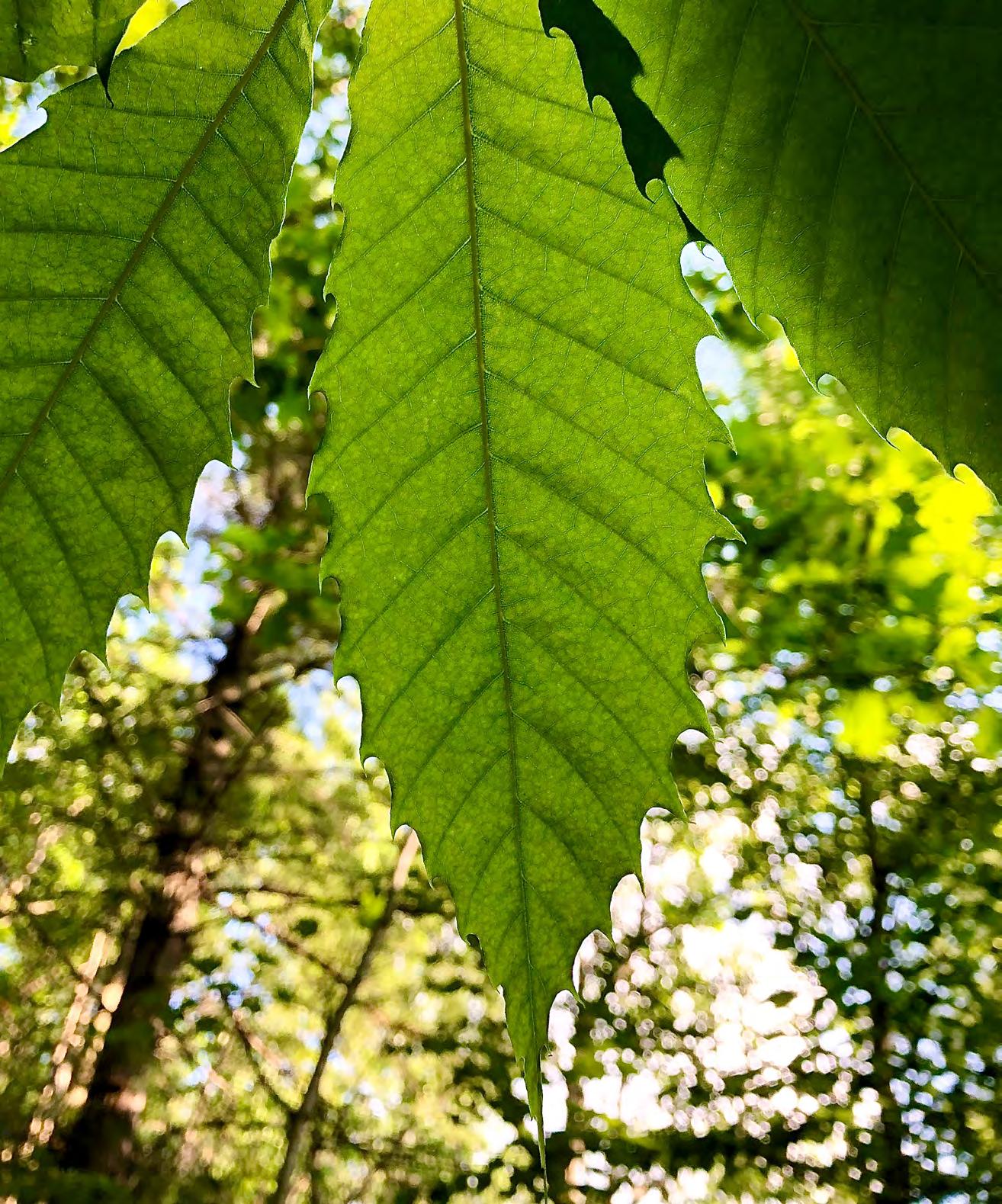
SPRING 2023 ~ ISSUE 2 VOL. 37 Lost
~ Birches School ~ George
First Hundred Years ~ Forest Management Strategies THE JOURNAL OF THE AMERICAN CHESTNUT FOUNDATION A BENEFIT TO MEMBERS HT E A MERICAN CHE STNUTFOUNDA T I O N 4Oth ANNIVERSARY 1983 – 2023
Chestnut Bee
Perry’s
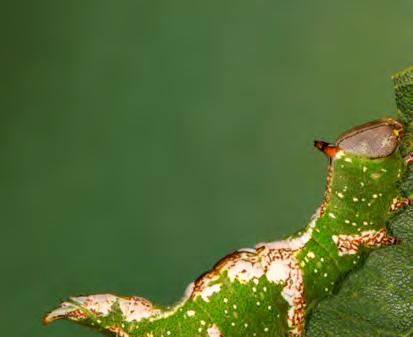

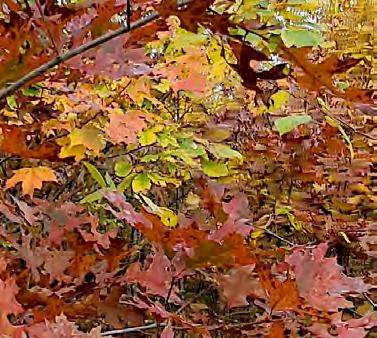

THE JOURNAL OF THE AMERICAN CHESTNUT FOUNDATION A BENEFIT TO MEMBERS Years as a: 8 34 REFLECTIONS 114-Foot-Tall Tree 35 RECIPE Dairy-Free Chestnut Parfait 11 NEWS Scouts from the Great Smoky Mountain Council A Township's Path to American Chestnut Restoration 22 RSC COLUMN Hindsight is 2008: Revisiting TACF's Oldest Progeny Tests 26 SCIENCE Feeding Insects Forest Management Strategies 36 TRIBUTE Blair Carbaugh 37 IN HONOR AND IN MEMORY 20 MEADOWVIEW A View from Meadowview 1 PRESIDENT’S MESSAGE from Lisa Thomson 15 VOLUNTEER SPOTLIGHT George Perry's First Hundred Years 3 NEWS Lost Chestnut Bee Douglasville, GA American Chestnut Restoration New Partnership with Birches School SPRING 2023 ~ ISSUE 2 VOL. 37
 Lisa Thomson President and CEO
Lisa Thomson President and CEO

DEAR CHESTNUT ENTHUSIASTS,
Experiencing the change of seasons is something I enjoy each year in the mountains of North Carolina. When polling friends and family on their favorite season, autumn immediately rises to the top due to the popularity of leaf peeping. Spring, however, is by far my favorite. This magical awakening also signals yet another growing season for the hundreds of chestnut orchards managed by volunteers, staff, and collaborators. Every year spring brings increased hope for potential new discoveries and ever-stronger trees in our collective breeding programs.
2023 could arguably be one of the most pivotal in TACF’s 40-year history. We are preparing for the hopeful deregulation of the Darling 58 transgenic tree; the launch of our documentary film, CLEAR DAY THUNDER: Rescuing the American Chestnut; initiating increased presence in Washington, DC with our new Government Relations Committee; a new brand identity thanks to Blue Ion, the brand agency we hired to solidify and consolidate our visuals and messaging; and finally, taking the bold step to grow our organization in staffing and stature.
The thorough search for my successor has concluded! TACF’s Executive Committee partnered with the highly respected search firm Kittleman & Associates to find the best possible future leader for the organization. Along with Chief Conservation Officer Sara Fitzsimmons providing a staff perspective, they took this search very seriously and I am grateful for their long hours and keen focus. We had more than 100 inquiries proving that TACF has indeed become a “talent magnet.” Join me in welcoming Dr. William “Will” Pitt in becoming TACF’s 6th President & CEO. Will was most recently Deputy Director at the Smithsonian Conservation Biology Institute leading six science centers and education and conservation programs, as well as administration and operations. As a researcher, he has focused on restoration of ecosystems, reducing the impact of invasive species, and training the next generation throughout his career. We will share more about Will and his credentials in the next Chestnut, because as of press time the announcement of his appointment was just a day old! Will begins his tenure on July 31 at the national office in Asheville. Please know how excited and committed I am to his success and a smooth transition.
Finally, look for invitations and announcements about screenings of our documentary in your area. Our distribution and promotion firm, Marketing Outpost, is coordinating these screenings throughout the eastern U.S. Read more on page 8 about the film, its purpose, and how you can host or attend a screening.
Gratefully,
 Lisa Thomson, President and CEO The American Chestnut Foundation
Lisa Thomson, President and CEO The American Chestnut Foundation
PRESIDENT’S MESSAGE The Journal of The American Chestnut Foundation ~ 1
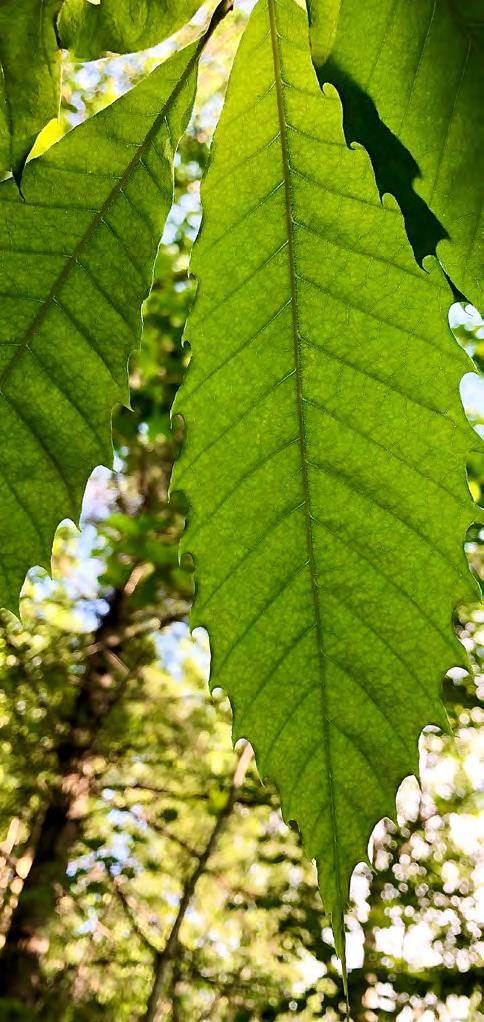
2022
Photo Contest Winner
“Chestnut Leaves”
The winning photo, simply titled “Chestnut Leaves,” was taken by 15-year-old Chase Witmer in Centre County, PA on land that has been in his family for 100+ years. From a very early age, Chase’s dad began telling him stories about the American chestnut that he heard from his father. Since that time, Chase has been studying the trees on the property and visits them often. He is looking forward to a future career in forestry.
WHAT WE DO
The mission of The American Chestnut Foundation is to return the iconic American chestnut to its native range.
CONTACT US: chestnuts@acf.org • acf.org facebook.com/americanchestnut • twitter.com/chestnut1904 • instagram/tacf1983
TACF National Office 50 N. Merrimon Avenue Suite 115 Asheville, NC 28804 (828) 281-0047
Meadowview Research Farms 29010 Hawthorne Drive Meadowview, VA 24361 (276) 696-9142
Mid-Atlantic Regional Office
Virginia Department of Forestry Central Office 900 Natural Resources Drive Charlottesville, VA 22903
New England Regional Office
UVM Aiken Forestry Service Labs / USFS NRS 705 Spear Street South Burlington, VT 05403 (802) 999-8706
OFFICERS
CHAIR:
William J. (Jay) Cude, III, TN
VICE CHAIR AND GOVERNANCE COMMITTEE CHAIR:
Rebecca (Becky) Carter, GA PROMOTION AND OUTREACH COMMITTEE CHAIR: Betty McDonald Allison, NC
SECRETARY/TREASURER AND FINANCE COMMITTEE CHAIR: Barbara Tormoehlen, IN SCIENCE AND TECHNOLOGY CHAIR: Deborah Delmer, Ph.D., NC
PRESIDENT AND CEO: Lisa Thomson, NC
BOARD OF DIRECTORS
Mandy Adler Cromwell Ph.D., MA
Bruce Levine, MD, Chapters Committee Chair
Dennis Liu, Ph.D., NC
Lewis Lobdell, PA
Ambassador Catherine Novelli, VA, Government Relations Committee Chair
John Scrivani, Ph.D., VA, Restoration Committee Chair
Jim Searing, PA
Anna Sproul-Latimer, VA
ADVISORS TO THE BOARD
Brian McCarthy, Ph.D., OH, Immediate Past Chair
Charles G. Meyer, III, VA, Legal Counsel to the Board
Kim Steiner, Ph.D., PA, Science Advisor to the Board
EMERITUS MEMBERS
Essie Burnworth (posthumously)
Gary P. Carver, Ph.D.
Hill Craddock, Ph.D.
Herbert F. Darling, Jr.
Michael Doochin
Hugh Irwin
William G. Lord, D.V.M. (d)
William L. MacDonald, Ph.D.
Rex Mann
Glen Rea
Kim Steiner, Ph.D.
Rufin Van Bossuyt
Richard Will (d)
Donald C. Willeke, Esq.
HONORARY DIRECTORS
Norman Borlaug, Ph.D. (d)
President Jimmy Carter
Richard A. Jaynes, Ph.D.
Mrs. Mary Belle Price (d)
Peter H. Raven, Ph.D.
Philip A. Rutter
Edward O. Wilson, Ph.D. (d) STAFF
ASHEVILLE
Lisa Thomson, President & CEO
Lesley Heiser, Grants Manager
Shaomin Li, Controller
Cherin Marmon-Saxe, Director of Operations
Cara Parker, Office Administrator
Carrie Plaxco, Gifts and Records Specialist
Jules Smith, Director of Communications
Jared Westbrook, Ph.D., Director of Science
North Central Regional Office
Pennsylvania State University 108 Business Services 206 Forest Resources Lab University Park, PA 16802 (814) 863-7192
Southern Regional Office 50 N. Merrimon Avenue Suite 115 Asheville, NC 28804 (828) 281-0047
Barbara Wood, Membership Coordinator
Shana Zimnoch, Director of Donor Engagement
MEADOWVIEW
Eric Jenkins, Tree Breeding Coordinator
Vasiliy Lakoba, Ph.D., Director of Research
Dan Mckinnon, Director of Land Management
Cassie Stark, Lab Manager
Jim Tolton, Facilities and Grounds Technician
Ciera Wilbur, Nursery Manager
REGIONAL STAFF
Sara Fitzsimmons, North Central Regional Science Coordinator and Chief Conservation Officer
Stephen Hoy, North Central Regional Science Coordinator
Kendra Collins, New England Regional Science Coordinator and RSC Manager
Catherine Martini, Northern Regional Outreach Coordinator
Jamie Van Clief, Southern Regional Science Coordinator
Hannah Leeper, Southern Regional Outreach Coordinator
EDITORIAL
Lisa Alford, Design & Layout
Scott Carlberg, Contributing Author
2 ~ A Benefit to Members
THE SEARCH FOR THE Lost Chestnut Bee,
ANDRENA REHNI
By Jack Swatt, CT Chapter President
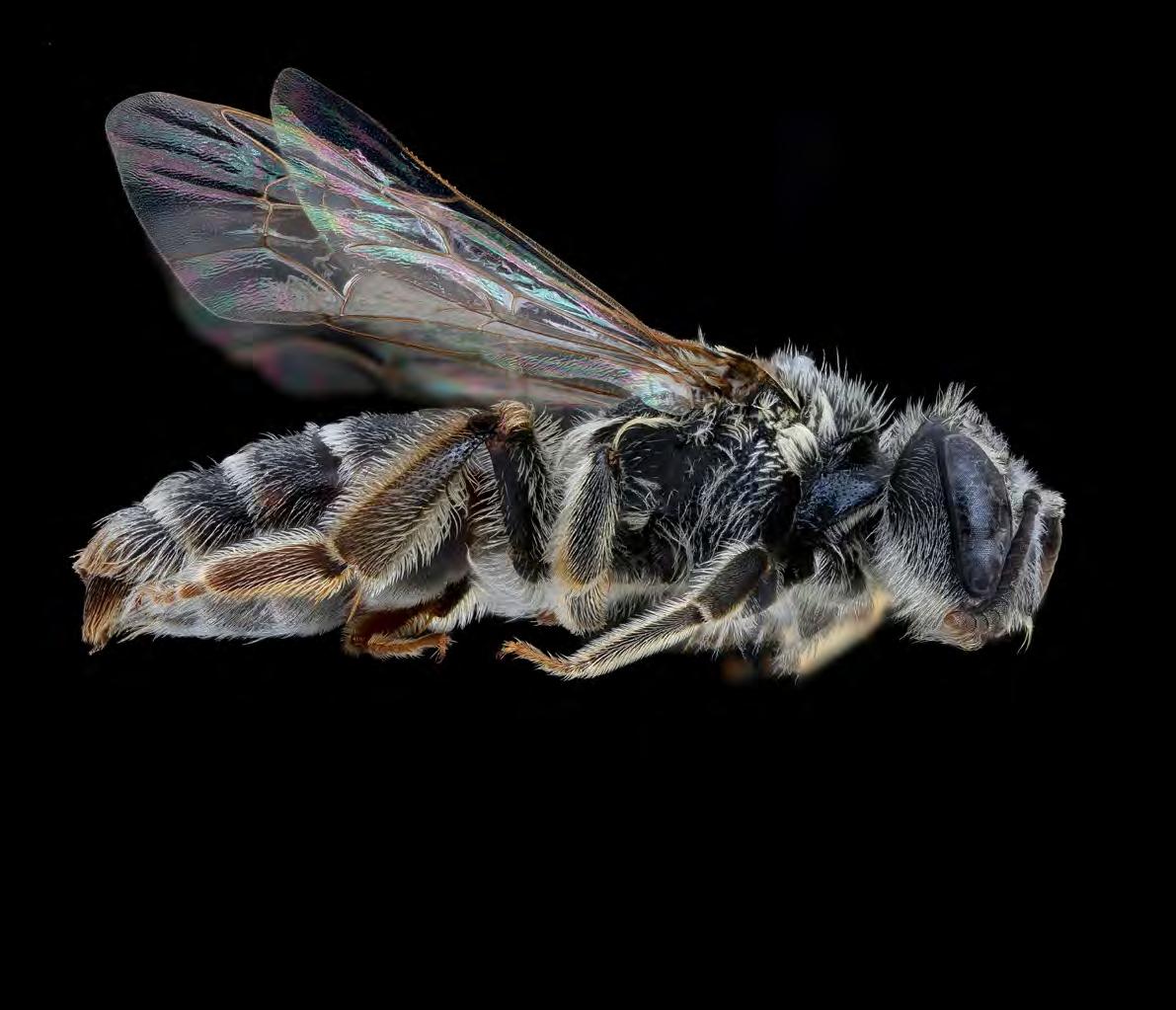
We all know how the loss of the American chestnut (Castanea dentata) was devastating to the inhabitants and wildlife of the eastern forests. Although not as abundant, the forest offered alternate means of sustenance, and most woodland inhabitants adapted to utilize alternatives for food and shelter. But a small group of woodland creatures had evolved to be totally dependent on the tree. Every summer, chestnut trees produced an abundant display of fragrant flowers when no other forest tree was blooming. These
blooms attracted a multitude of bees, moths, beetles, and other insects, and while most of those species are generalists (utilizing whatever flowers are available), some insect specialists evolved to exclusively utilize chestnut to supply their young with food and complete their life cycle. In 1977 Paul Opler, of the U.S. Fish and Wildlife Service Office of Endangered Species, proposed that there were seven species of moths that may have gone extinct due to the loss of the American chestnut (Table 1).
American chestnut is suspected to be primarily wind pollinated with
some additional help from moths. In 2019, two events happened that may alter that perception. Sam Droege of the U.S. Geological Survey (USGS) Patuxent Wildlife Research Center in Maryland and Morgan Lowry of the Connecticut Agricultural Experiment Station (CAES) in Hamden, CT, both independently collected specimens of a bee, Andrena rehni, also known as Rehn’s miner bee. As Droege recalls, “I had never seen this bee before, and when I looked it up, it turned out to be Andrena rehni. That’s interesting, there were no records for Maryland and the bee hadn’t been seen in
Andrena rehni female found at Lockwood Farms, Hamden, CT.
The Journal of The American Chestnut Foundation ~ 3 NEWS FROM TACF
Photo by Cole Cheng, courtesy of USGS Bee Inventory and Monitoring Lab.
almost 75 to 100 years.” Miner bees are solitary nesting bees which dig tunnels into the ground, provision their nest cells with pollen and nectar for their larvae to feed on, mature, and complete their life cycle the following year. There are hundreds of species in the genus Andrena, some of which have evolved to utilize a particular food source to feed their growing larvae. Several early entomologists included A. rehni in their collections and several specimens were obtained from flowering chestnut trees. Droege collected the bee from a flowering chinquapin tree (Castanea pumila). The bee’s reported range also coincided with the range of the American chestnut. Reports of this bee dropped off significantly through the 1910s and the last reliable record occurred in 1921. Suspicion was high that this longlost bee was a chestnut, or more specifically, a Castanea specialist.
Word got out about the finding of these rare bees and it was also picked up by social media. Bee collectors who
knew where chestnut trees were located began searching through the fragrant blooms and more specimens of A. rehni were being found (Table 2). In 2020, entomologist Michael Veit contacted the MA/RI Chapter to find out where to locate flowering chestnut trees to survey. He and a few volunteers visited some of the Chapter orchards and other locations where wild chestnuts were known to flower. At a natural disturbance at Mt. Ella in Monson, MA, three female specimens of A. rehni were found. Collections at the other sites did not yield any new records. In 2021, the CT Chapter and entomologists at CAES joined in to recruit more volunteers and perform a wider and more thorough search for the bee. While the primary goal was to determine the distribution and abundance of A. rehni, data was also collected to determine the diversity of bees and other insects visiting chestnut flowers and whether any were seen visiting female flowers. Over the next two summers 27 sites in CT, MA, RI, and NH were surveyed,
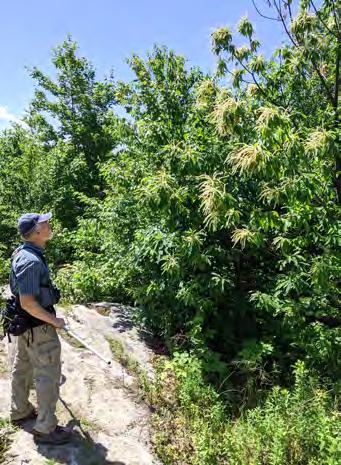
including wild trees and orchards of various chestnut species. In 2021, a wet early summer inhibited bee collection. The bee was found again at Mt. Ella, but also at an additional site of flowering wild American chestnut trees at Mt. Tom in Easthampton, MA. The 2022 season brought better weather and, for the first time, the chestnut bee was found at TACF backcross orchards in Littleton, MA, Middlefield, CT, and Salem, CT.
Argyresthia castanella
Coleophora leucochrysella
Ectoedemia castaneae
Ectoedemia phleophaga
Tischeria perplexa
Swammerdamia castaneae
Synanthedon castaneae
Chestnut ermine moth
Chestnut casebearer moth
American chestnut moth
Pleophagan chestnut moth
Chestnut clearwing moth
Chestnut Yponomeutid moth
Chestnut clearwing moth
SOURCE: Insects of American Chestnut: Possible Importance and Conservation Concern, Paul A. Opler, Office of Endangered Species, U.S. Fish and Wildlife Service, Washington. DC 20240, December 15, 1977
Also found in the Proceedings of the American Chestnut Symposium, Morgantown, WV Jan 4-5, 1978: www.fs.usda.gov/nrs/pubs/jrnl/1978/ne_1978_macdonald_chestnutproc.pdf
While researchers at CAES were helping with the collection of bees throughout CT, they also did a more extensive survey of the trees at their Lockwood Farms complex in Hamden, where one of the original A. rehni discoveries took place. If there ever was a place where insects dependent on chestnut could survive it would have to be Lockwood Farms. Since the early years following the blight, plant scientists have been researching means to combat the blight and planted thousands of pure and hybrid chestnut trees of all Castanea species. Tracy Zarrillo, a CAES entomologist, is leading the survey of bees utilizing the flowering Castanea trees at Lockwood
Michael Veit at Mt. Ella.
TABLE 1: Insects presumed to be extinct due to the loss of the American chestnut
NEWS FROM TACF 4 ~ acf.org

foraged on just American chestnut and native chinquapin species or if foreign Castanea species would also host the bee. At Lockwood, A. rehni was collected from the flowers of all types of Castanea species and one hybrid tree. An additional single bee was also collected at a Japanese chestnut tree in Old Lyme known to have been planted in 1876. And there is still much more research to be done. So far, all the bees collected have been by netting, but Zarrillo is experimenting with bee traps that can
TABLE 2: Locations where A. rehni has been found
2019 Patuxent Wildlife Research Center Laurel, MD
2019 Lockwood Farms Hamden, CT
2020 Hybrid Chestnut Orchard Davidsonville, MD
2020 Mount Cuba Center Hockessin, DE
2020 Mt. Ella Monson, MA
2021 Mt. Tom Easthampton, MA
2022 Roger Tory Peterson Estuary Center Old Lyme, CT
2022 TACF Backcross Orchard Littleton, MA
2022 TACF Backcross Orchard Middlefield, CT
2022 TACF Backcross Orchard Salem, CT
If you would like to help search for the bee in your area, contact Sam Droege at sdroege@usgs.gov, Michael Veit at beedude76@gmail.com, or Tracy Zarrillo at Tracy.Zarrillo@ct.gov.
be hung during the entire flowering period. As Zarrillo also noted, “Since persisting at Lockwood, it seems like it would be a great place to do some deeper natural history work, especially if I can find where they are nesting.” Scientists still need to determine how dependent A. rehni is on Castanea species, and to what extent this bee contributes, if at all, to chestnut pollination.
Of the moth species that were presumed to be extinct, two of the species were subsequently found to exist. The chestnut bee, A. rehni, was not even on entomologists' list of potentially endangered insects due to the demise of the chestnut.
As Droege points out, “Are these things really going extinct, or are we just not looking hard enough for them?” In the decades that TACF has worked on our mission to restore the American chestnut, we have planted many thousands more chestnut trees. Just as Lockwood Farms has been a safe haven for the chestnut bee, each of our orchards and plantings can become a potential location for species dependent on chestnut to thrive once again. We are working to save one species, but in effect, we may be saving many more.
NEWS FROM TACF The Journal of The American Chestnut Foundation ~ 5

DOUGLASVILLE, GA IS SERIOUS ABOUT American Chestnut Restoration
By Lisa Thomson, TACF President & CEO
On a brisk February day in Douglasville, Georgia, a group of Future Farmers of America (FFA) students from Alexander High School (AHS) hosted an Arbor Day Restoration Celebration in the classroom of Ryan Bragg, their agricultural teacher. This event was yet another effort by the DouglasvilleDouglas County Friends of the American Chestnut (“the Friends”), a brainchild of chestnut enthusiast Dorothy “Dot” Padgett, who chairs the group with her committee of ten city and county representatives, naturalists, master gardeners, and concerned residents. Along with plantings and other educational programming, Dot has almost singlehandedly brought the story of the American chestnut restoration to her beloved hometown. For those of you who don’t know Dot, her background is quite remarkable. First of all, at 95 years young, she actually remembers seeing the ghostly, dying canopy of chestnuts from an airplane as a young

person, which made a huge impression on her. Later she worked as lead organizer for President Jimmy Carter’s grassroots “Peanut Brigade” campaign which helped him become elected. She authored a book on the experience, Jimmy Carter Elected President with Pocket Change and Peanuts. Dot also served in his administration as Assistant Chief of Protocol. Dot opened up the festivities with introductions of distinguished guests, which included the Mayor of Douglasville, Rochelle Robinson; Douglas County Commission Chairman, Romona Jackson Jones; Bruce Moltzan from the U.S. Forest Service’s Washington, DC office; Becky Carter, TACF board member, and Jack and Patti Rogers of the GeorgiaTACF Chapter. Dot also gave remarks about the history of “the Friends” and turned it over to the principal of Alexander High, Chris Small, who complimented the students and Bragg for their efforts to incorporate
Dot Padgett, GA Chapter member and event organizer, welcomes guests at the Arbor Day Restoration Celebration.
NEWS FROM TACF 6 ~ A Benefit to Members
Senior Ava Holcomb’s gorgeous color pencil drawing of a spreading chestnut.


Participants listen to Lisa Thomson speak about the plight of the American chestnut and its hopeful return.

the story of the American chestnut into their classroom curriculum. After Bragg greeted guests, I presented a brief slide show on the mission of The American Chestnut Foundation (TACF) and shared the trailer of TACF’s documentary film. After a rousing game of “Chestnut Jeopardy” where students competed for copies of Mighty Giants, a book about the history of the American chestnut, the poetry and art contest winners from AHS were announced. Senior Logan Bradd recited his poignant poem
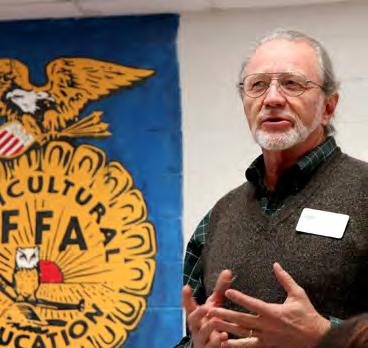

about the loss and hopeful return of the tree and received a standing ovation. His poem can be found in the Reflections section of this issue on page 34. Senior Ava Holcomb described the process of creating her gorgeous color pencil drawing of a spreading chestnut that was evocative and beautifully rendered. Both students were given well deserved accolades and cash prizes.
AHS also maintains a planting of American chestnut hybrids on their campus, whose care is passed
down to subsequent agricultural and FFA students over the years to encourage a new generation of chestnut enthusiasts. I was touched and inspired by the day, showcasing how one passionate and extraordinary organizer, Dot Padgett, can pull together a diverse group of local politicians, state and national agency representatives, spirited volunteers, and eager students to celebrate our unique and hopeful mission of the return of this foundational tree species.
Logan Bradd, winner of the poetry contest, reads his poem and receives a standing ovation.
Ryan Bragg, Alexander High School agricultural teacher, speaks to participants in his classroom where the event took place.
Ava Holcomb describes her winning piece to TACF President & CEO Lisa Thomson.
GA Chapter President Jack Rogers shares information about the restoration work of the Chapter.
NEWS FROM TACF The Journal of The American Chestnut Foundation ~ 7 The Journal of The American Chestnut Foundation ~
This film is a story about a tree that once graced the forests of Appalachia, nurtured communities, and held us from cradle to grave. It is a story about the people whose unwavering determination to save it has ignited a scientific path for restoration. It is a story about the promise of healthier forests for future generations who will inherit a brighter world because of its survival. We want the film to reach a broad audience, raising awareness about the plight of this invaluable tree species and its hopeful future. And you can help! CLEAR DAY THUNDER: Rescuing the American Chestnut will be available for public and private screenings among TACF’s four regions in the tree’s native range. To learn more about the documentary and how you can coordinate a screening in your state chapter, visit the film’s website at RescuingTheAmericanChestnut.com. WE ARE THRILLED TO CELEBRATE THE


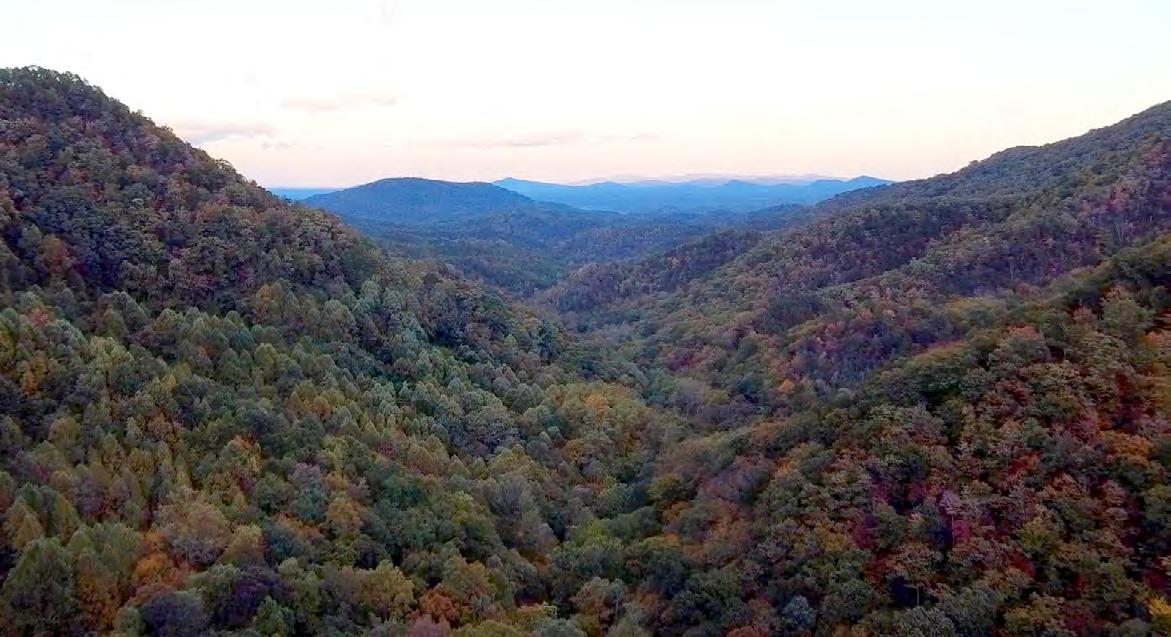

THE AMERICAN CHESTNUT FOUNDATION’S Long-Anticipated Documentary IS NOW A REALITY! RescuingTheAmericanChestnut.com
RELEASE OF CLEAR DAY THUNDER: RESCUING THE AMERICAN CHESTNUT .
MA/RI CHAPTER CELEBRATES New Partnership with Birches School
By Kathy Desjardin, MA/RI Chapter President and Mark Meehl, MA/RI Chapter Orchard Manager
The MA/RI Chapter is excited about a new partnership with the Birches School, a nature-based pre-kindergarten through eighth grade campus in Lincoln, MA.
Director of Auxiliary Programs Ken Clarkson noticed mudpacking on one of two flowering wild American chestnut trees on the school’s property that he had been watching for more than a year. (Mudpacking is applied to blight cankers to introduce micro-organisms that compete with the fungus in an effort to prolong the life of infected trees.) Upon his observation, Ken immediately saw this as a wonderful learning opportunity for the students, but he
needed to find out who had treated the trees. He contacted MA/RI Chapter President Kathy Desjardin who confirmed that the Chapter was indeed taking care of the trees.
Kathy connected Ken with Mark Meehl, manager of the Chapter’s Flint Field Germplasm Conservation Orchard (GCO) nearby, who had performed the mudpacking. Mark followed up with a visit to the school and offered a brief presentation to students and faculty sharing information

NEWS FROM TACF The Journal of The American Chestnut Foundation ~ 9
Historical image of the large American chestnut tree (left, center) that was commemorated in stone after succumbing to the blight in the early 20th century. Courtesy of Lincoln Town Archives.
about how they could be involved in American chestnut restoration. Mark suggested applying another mudpack in the spring, watering the mudpack for effectiveness, and frequent visits to the Flint Field GCO. He also explained the differences between backcross breeding and the transgenic program. Birches School is fortunate to have two flowering wild Americans located on their grounds. These might also be pollinated with transgenic pollen if regulatory approval is granted this spring.
With so much interest and enthusiasm from the students and school leaders, Mark and Ken requested that the students finish planting the remaining 60 trees in April to complete the Flint Field GCO of 400 trees. Mark and Ken have encouraged student involvement in this project and are excited about the benefits of this partnership. Work will involve potting-up replacement seedlings, cutting plastic ground cloth, digging holes, planting nuts, and giving guided tours. Student participation will help educate the entire community about American chestnut restoration. The students’ efforts will also provide a pathway for future breeding programs to be transferred to younger generations. The collaborative goal is that Birches School
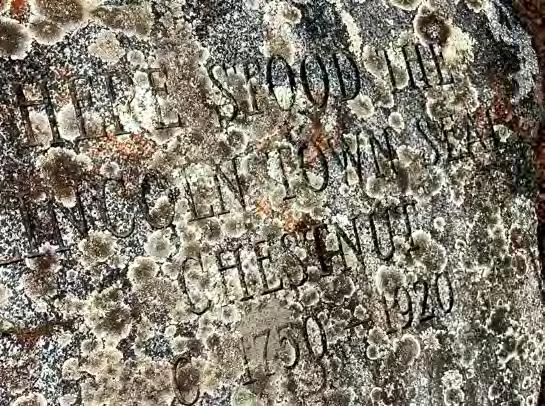
Town of Lincoln, MA stone in front of Bemis Hall “Here Stood the Lincoln Town Seal Chestnut C 1750-1920.”

students will continue caring for the trees in the years ahead and play an active role in TACF’s reforestation programs.
In the 19th century, the town of Lincoln, MA was known for its enormous American chestnut tree in the heart of the historic district, which also appears on the town seal. Like most American chestnut trees, it sadly succumbed to the blight fungus in the first part of the 20th century. Grief-stricken townspeople marked its location by the side of Bemis Hall with a large granite stone engraved with “HERE STOOD THE LINCOLN TOWN SEAL CHESTNUT
C 1750-1920” in memory of Lincoln’s great American chestnut tree. A deep depression 6-7 feet in diameter surrounds the granite stone where the root system beneath has collapsed, indicating just how enormous this tree actually was. Lumber from the tree now panels Lincoln’s Town Hall “Donaldson Room.’’ Clearly, the town of Lincoln has a historic interest in the American chestnut, which continues today. Birches School students are our future chestnut tree farmers, young people who are moving our mission forward.
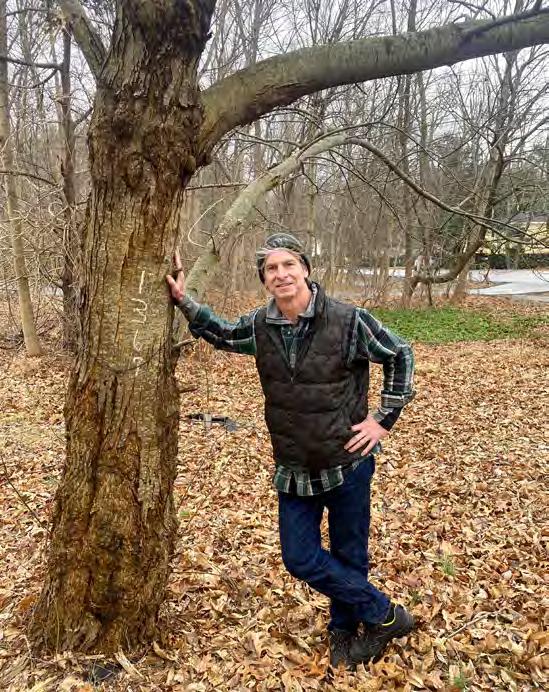 GCO Manager Mark Meehl at Flint Field, Lincoln, MA.
GCO Manager Mark Meehl at Flint Field, Lincoln, MA.
NEWS FROM TACF 10 ~ A Benefit to Members
Birches School teacher Ken Clarkson stands by one of the American chestnut trees on the Birches School grounds.
Scouts from the Great Smoky Mountain Council
IN EAST TENNESSEE HELP TO RESTORE THE AMERICAN CHESTNUT
By Trent Nichols, Activities and Civic Service Chair, Great Smoky Mountain Council of the Boy Scouts of America, and April McMillan, Chief Experience Officer, Great Smoky Mountain Council of the Boy Scouts of America (BSA)
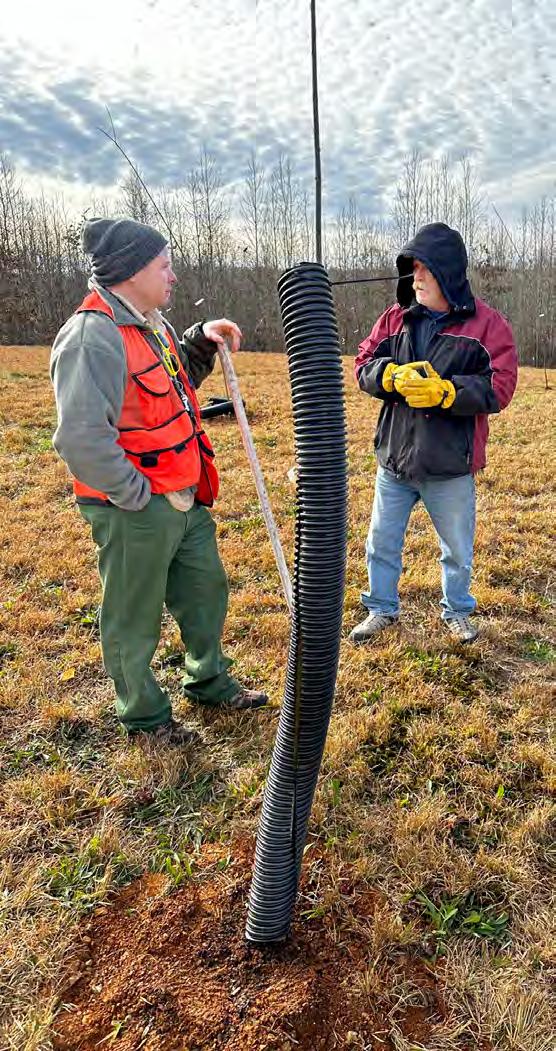
On a mild early December morning in the middle of East Tennessee, 85 Cub Scouts, Scouts BSA, Venturers, and Sea Scouts, along with many adult volunteers from across the 21 counties served by the Great Smoky Mountain Council (GSMC) of the Boy Scouts of America, gathered to assist in the restoration efforts of the American chestnut. The Scouts, who were provided support materials and advanced resources, planted 100 trees on December 3 and 19 at the GSMC’s Camp Buck Toms (CBT) in Rockwood, TN. Additional adult volunteers and Scouts, along with Roane County’s Tennessee Wildlife Resources Agent (TWRA) agent Joe Johnson, returned to CBT two weeks later to install deer browse and rub protection on every tree to ensure that each was further stabilized and protected by using the extra resources provided to GSMC’s adult volunteers and Scouts.
David Hillis of the Little River Nursery in McMinnville, TN had grown the trees in his nursery. They were 22-monthsold at planting and were grown from nuts obtained from the University of Tennessee at Chattanooga’s (UTC) greenhouse. The American chestnut work at UTC is in partnership with The American Chestnut Foundation (TACF). These trees were transported as seedlings that were then grown into 10’-12’ trees, then planted.
In the future, Scouts of all ages (7-18 years) will be able to come to the CBT chestnut orchard each spring to gather nuts for planting. It is hoped that Scouts and their families will return to Camp Buck Toms year after year to visit the trees they planted and watch them grow. But this is only the beginning! The GSMC will monitor the orchard and continue working with TACF for many years to come. We hope to be the first among many youth-serving organizations to contribute large amounts of data toward further restoration success of these invaluable trees. Next year GSMC plans to partner with its sister BSA Council in upper East Tennessee, the Sequoyah Council at Camp Davy Crockett, and again with CBT in a second round of plantings.
In fact, to help better understand the impact of the citizen science of this conservation project, Hill Craddock, board emeritus at TACF and professor at UTC, joined the planting at TBC and shared inspiring information
NEWS FROM TACF The Journal of The American Chestnut Foundation ~ 11 The Journal of The American Chestnut Foundation ~
A representative of the Tennessee Wildlife Resource Agency (TWRA) and the Camp Buck Toms (CBT) ranger.

Adult volunteers and Scouts arrive early on a gray December morning to participate in efforts to return the American chestnut to the preeminence that it enjoyed 100 years ago.

A sapling is labeled and hopefully on its way to becoming a beautiful, healthy tree.
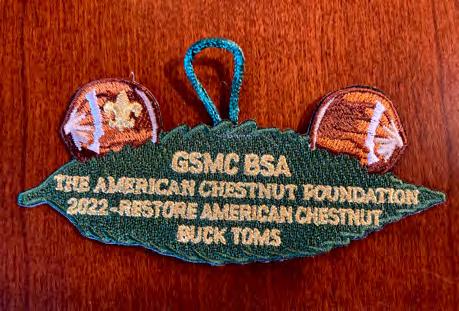
chestnut tree. Craddock also helped the Scouts understand the science behind TACF’s research and restoration efforts. He was very helpful in demonstrating planting techniques – a real treat for those who have never experienced how to properly plant a tree!
Scouts who planted the 100 trees earned an attractive patch (pictured above) for their participation and hard work. Not only did this unique patch incentivize the Scouts and volunteers but, hopefully, the experience has led to “planting” the idea of conservation in the young minds of these Scouts; one that will last a lifetime. Plant a tree, grow a Scout! The GSMC is proud to be in partnership with TACF and looks forward to all of the future opportunities to come.
AUTHOR BIOS
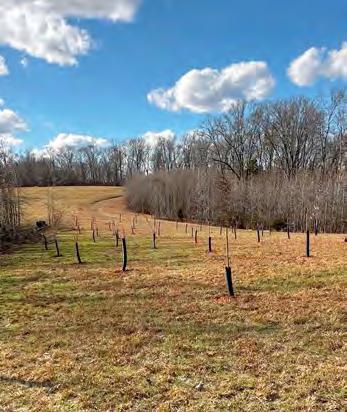
The finished orchard of American chestnuts that will be watered this summer by Scouts who will take care of the trees during their week of summer camp at Camp Buck Toms.
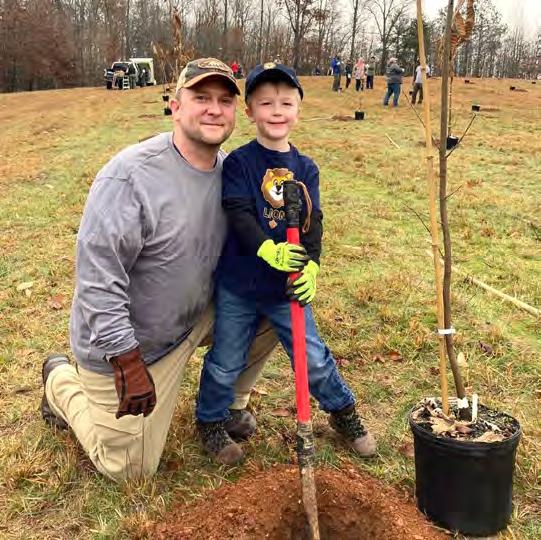
and thrilled to be planting
TRENT NICHOLS, M.D., Ph.D., is the lead volunteer for the Council in developing and organizing activities and service opportunities for the thousands of Scouts across the 21 counties served by the Great Smoky Mountain Council, BSA (GSMC).
APRIL MCMILLAN, Ph.D., is honored to serve as the Chief Experience Officer for GSMC. She is the scouting professional who oversees all program and properties, including advancement, training, civic service, and camp operations & maintenance, among many other opportunities to serve the Scouts, volunteers, and families in East Tennessee.
A Cub Scout with his father who is proud
a chestnut.
NEWS FROM TACF 12 ~ acf.org

A Township’s Path to
AMERICAN CHESTNUT RESTORATION
By Tom Wrasse, IN Chapter
A rural township can be used to communicate and offer rural residents the opportunity to participate in the mission to restore the American chestnut to its rightful place in our eastern U.S. forests. It is one of the smallest governing bodies, but has a big voice in how we shape our rural landscape.
As a member of Bertrand Township’s zoning board and The American Chestnut Foundation (TACF), I saw an opportunity to involve the township administration in TACF’s mission. The Township Hall sat on 10 acres of mostly unused property. When the township’s board members were introduced to the history of the American chestnut, the blight’s devastating impact, and the unwavering efforts of TACF volunteers to restore the tree, they were eager to get involved, recognizing the benefits to the community. As a member of TACF, I offered to supply seedlings and free labor through Boy Scout Troop 541. This collaborative endeavor could be accomplished without involving money from the township’s taxpayers.
In the spring of 2015, 30 American chestnut seeds were potted, 10 of which were earmarked for the Bertrand Township planting. A local “Earth Care Congregation” Presbyterian Church offered to purchase cage materials. I gave a presentation to Scout Troop
541 about the significance of the tree and how to conduct the township planting. By Early October everything was ready to go. It was a festive atmosphere at the planting with township officials and family members, church congregants, and Scouts, including their parents. A local reporter from the South Bend Tribune even attended to cover the event.
Over the next five years activities continued as word spread about the township’s restoration efforts. Lectures and presentations were shared at garden clubs, a day camp workshop was offered at the Fernwood Botanical Garden, and everyone from senior citizens to conservation groups participated in some way. Eight more demonstration orchards and plantings were also accomplished. These orchards included one with the Pokagon Band of the Potawatomi Indians.
An Eagle Scout badge was earned three years ago by Kadin Mills from Troop 541 when he planted
NEWS FROM TACF The Journal of The American Chestnut Foundation ~ 13
Chestnut seedling sale at Vitis Greenhouse in 2021. These seedlings were grown by nuts obtained from the Bertrand Township orchard.

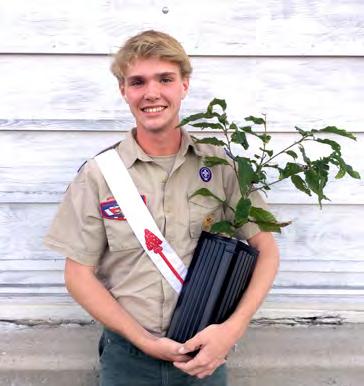
a ten-tree demonstration orchard at neighboring Buchanan Township. It included an information kiosk, pathways, and park benches.
In year six, the Bertrand Township trees were 20 feet tall and ready to produce fruit. Unfortunately, two trees died but most survived. The Leader newspaper carried the exciting story of a harvest that totaled 160 nuts. Then the question of “What’s next?” came to mind. Nancy Lentsch, the township’s office manager, suggested that an invitation to adopt two chestnut seeds be shared in the township’s newsletter, along with planting instructions from the PA/NJ Chapter and membership brochures from TACF. A second opportunity to adopt seeds was presented during a
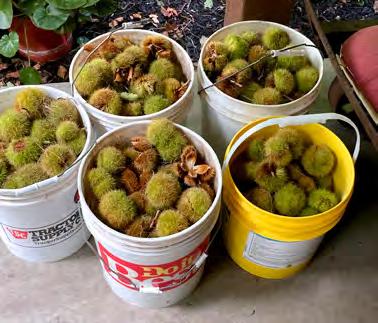

winter open house at the township. Fifty residents took the offer during this event, and a steady stream of others began coming to the township office that spring to obtain two or more seeds. The 39 seeds left were potted at Vitis Greenhouse, a multiacre operation in the heart of Bertrand Township. By June, those remaining seedlings had been sold at a $15 each.
The 2022 harvest at the Bertrand Township chestnut orchard yielded too many to count! Boy Scout Troop 541 was again asked to assist in the harvest. Five 5-gallon buckets overflowing with burs were collected, and more than 250 nuts went into cold storage.
The future of American chestnut restoration looks bright in Bertrand
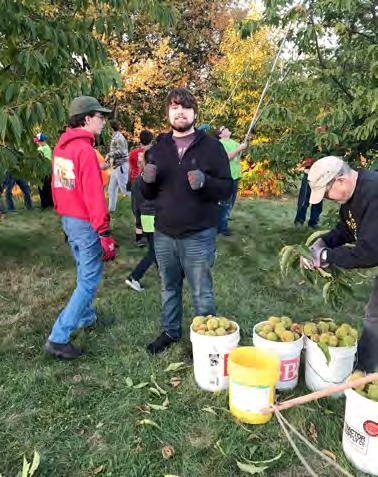
Township. Seven other orchard plantings are in the planning stages. Other rural townships across the tree’s native range could follow a similar path. Others in Michigan have started to notice Bertrand’s restoration activity. An association of Michigan Townships has a weekly posting of activities. I am sure a posting about American chestnut restoration would spark interest, as it did in the Bertrand Township. If other states have similar governmental communications, TACF members might want to consider developing those partnerships for the many benefits they provide now and well into the future.
Boy Scout Troop 541 poses for a photo after a successful harvest.
Eagle Scout Kadin Mills holds a seedling donated by The American Chestnut Foundation.
Troop 541 harvesting at the Bertrand Township orchard.
Buckets filled to the brim with burs.
14 ~ A Benefit to Members NEWS FROM TACF ~ A Benefit to Members
Troop members and leaders filling buckets with burs.


George Perry’s
FIRST HUNDRED YEARS
By Scott Carlberg, Contributing Author
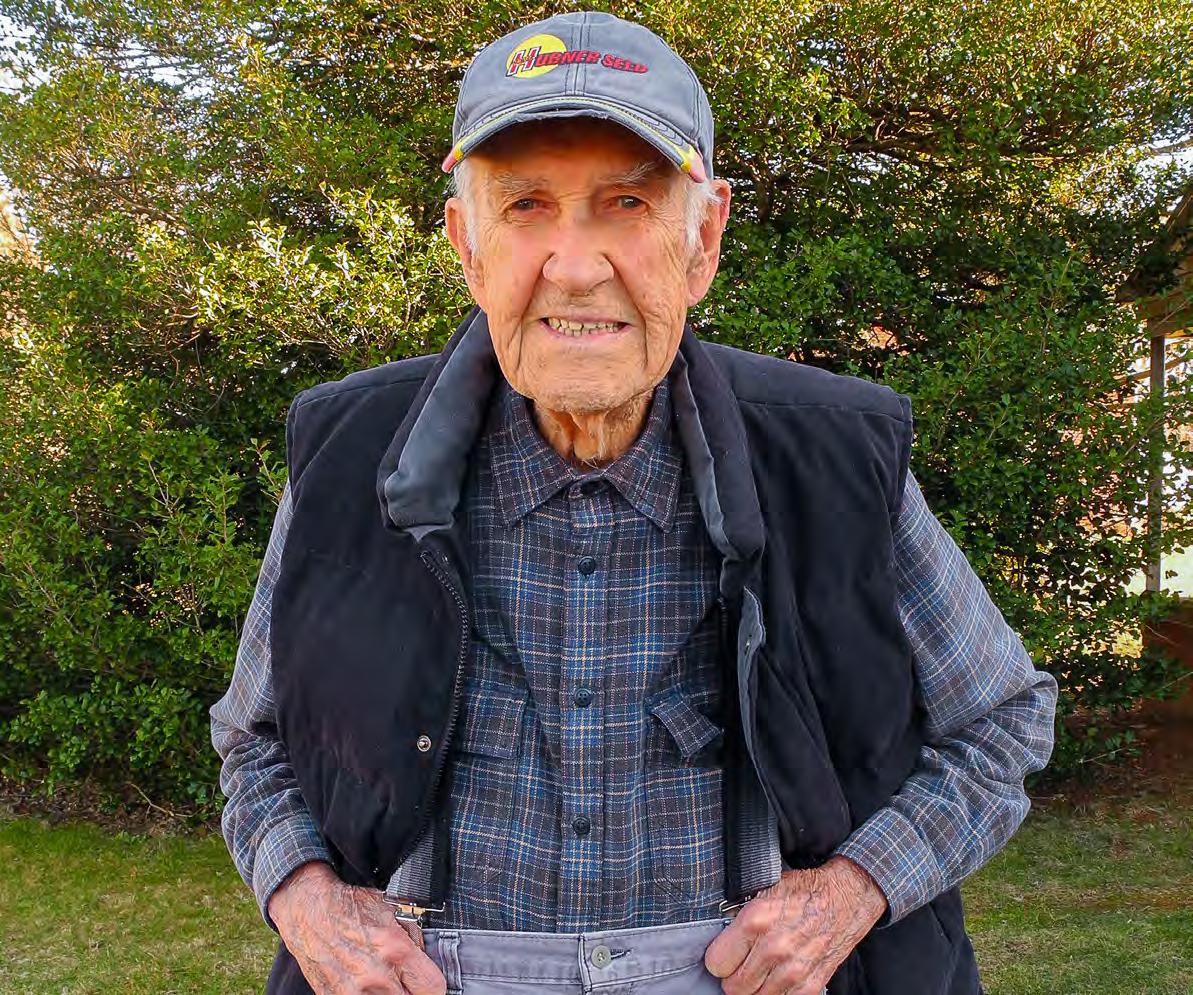
The Journal of The American Chestnut Foundation ~ 15 VOLUNTEER SPOTLIGHT PA/NJ CHAPTER
George Perry became a volunteer for The American Chestnut Foundation 25 years ago. That’s when he was 75 years old. But he has known chestnuts for all of his 100 years.
“I like eating them,” he says. “When dad bought our farm in 1923 and we moved, I was a year old. Up in the woods above the farm there were two dead chestnuts. He sawed them down and drug them to a sawmill. Made a chicken coop and a neighbor built a hog pen.”
When I interviewed George, I asked if he had photos of the old chestnut chicken coop.
“Why would we have taken a picture of a chicken coop?” he asked. Fair question.
MANY BRANCHES MAKE UP GEORGE’S 100 YEARS.
Childhood
“Chestnuts were something we always talked about. Dad’s brothers and sisters went out in the woodlands in late 1800s and early 1900s with a cloth bag and gathered chestnuts. They’d hang them in the garret of the house and roast them in the winter. Always fascinated me.”
Some chestnuts are still on the mountainside, and George is still out there gathering them. “Right now,
I gather from eight or nine trees. We have a store and sell what we don’t use.”
In 1940 George graduated from William Penn High School in York, Pennsylvania. Industrial training was the common path for grads.
The Farm
A commemorative calendar that will mark the 100th birthday of the Perry farm is in the works. The farm
has produced dairy, corn, soybeans, and hay. “Years ago in the 30s we had been growing potatoes, five acres of tomatoes, wheat, barley, oats. We would sell the surplus.”
Every year on the farm was a little different. “In early 1930s, the state of Pennsylvania came in and tested cows for bovine tuberculosis and Bang’s disease. They wanted a certified state clear of bovine tuberculosis. Three cows were taken away and
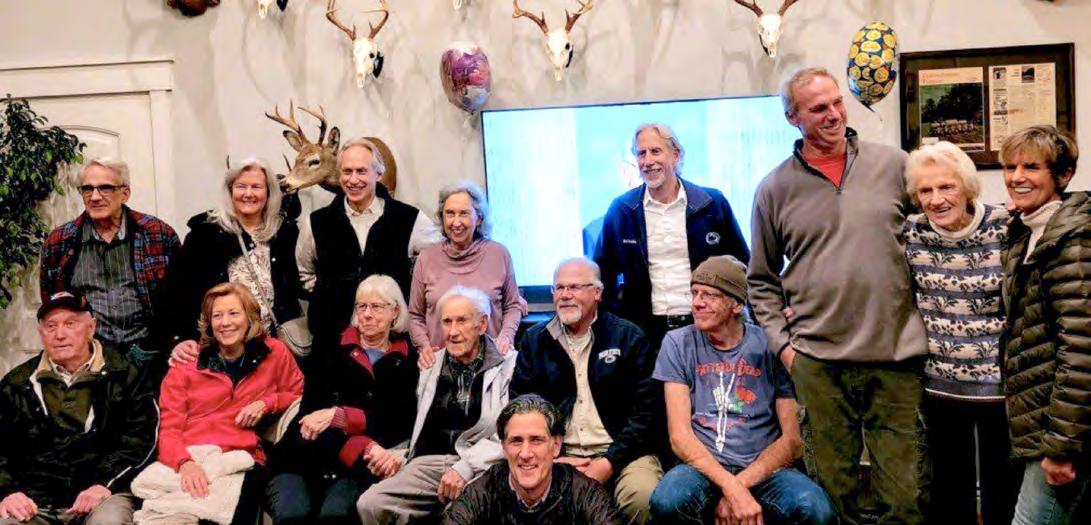 George Perry’s 100 Birthday celebration. (George is seated fourth from left.)
George Perry’s 100 Birthday celebration. (George is seated fourth from left.)
16 ~ acf.org VOLUNTEER SPOTLIGHT

we got paid indemnity. If you lost three cows in the 1930s, that hurt.”
George picks up eight or nine bushels of chestnuts a year now.
The farm store has been a fixture in the family. “We would pasteurize and homogenize milk, then deliver milk to preschool and Kindergarten students.”
World War II
The “Pennsylvania boys” comprised much of George’s Army unit. “I trained at Camp Bowie, Texas, and then Seattle. I ended up in 1943 in the South Pacific. I was a topographical surveyor and would compute the coordinates for artillery targets.”
Easter Sunday, just before dawn, was a defining time. “Standing on the troop carrier I watched planes try to shoot each other down. I had a Jeep and a driver. We were loaded with equipment for surveying and had to make sure it got delivered.” It did. As the Allies were preparing to invade Japan, the atom bomb was dropped. “That ended the war. I landed on the West Coast and there were thousands of cheering people on the wharf. Bands played. I boarded
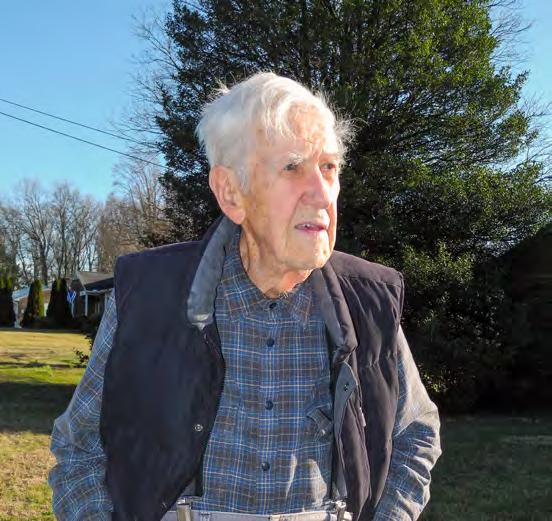
an old coal-powered troop train for the cross-country trip. The locomotive smoke blackened our faces. From the train I took a bus to York, then walked
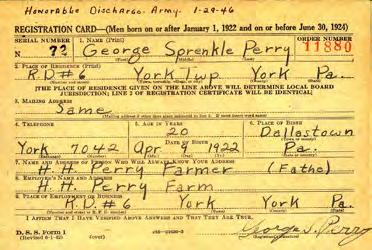
home. The family was sitting in the kitchen.” In ten days George went from Pacific battles to the family farm.
Marriage
“I got married when I was 36 years old. I’d been running around with members of a family a couple farms down. There were some younger sisters who always seemed to be around. (I never wanted my sisters around me.) Nancy was one of them
and we became good friends and we got married May 24, 1957.” The family grew to three sons and a daughter.
65 years later the marriage is going strong. George had to cut our first conversation short because he needed to run an errand. Nancy’s car was at the mechanic and she called, asking him to come get her. He tooled to the shop in his pickup. Yes, he is still driving at 100!
The Constant – Chestnuts
There are still some American chestnuts that grow from old trees near George. “Saplings send up shoots. In the last year they will blossom out and yield nuts. We will go into the hills and look for them.”
Preparing chestnuts is second nature to George. “No recipe. Peel off outer shell and boil five minutes. Put them on plate and microwave for six seconds or so, just enough steam to push the skin from the nuts."
What is it like turning 100?
“Embarrassing. People make too much of a fuss,” says George. But George shows that a hundred years later, there must be something to that chestnut diet.
George stands beside a chestnut tree at the home where he grew up.
This WWII military man is now in full retiree uniform.
Photo by John Ambler.
The Journal of The American Chestnut Foundation ~ 17 VOLUNTEER SPOTLIGHT
George’s military registration card. Courtesy of the National WWI Museum and Memorial, Kansas City.
Bolder Research, Greater Impact

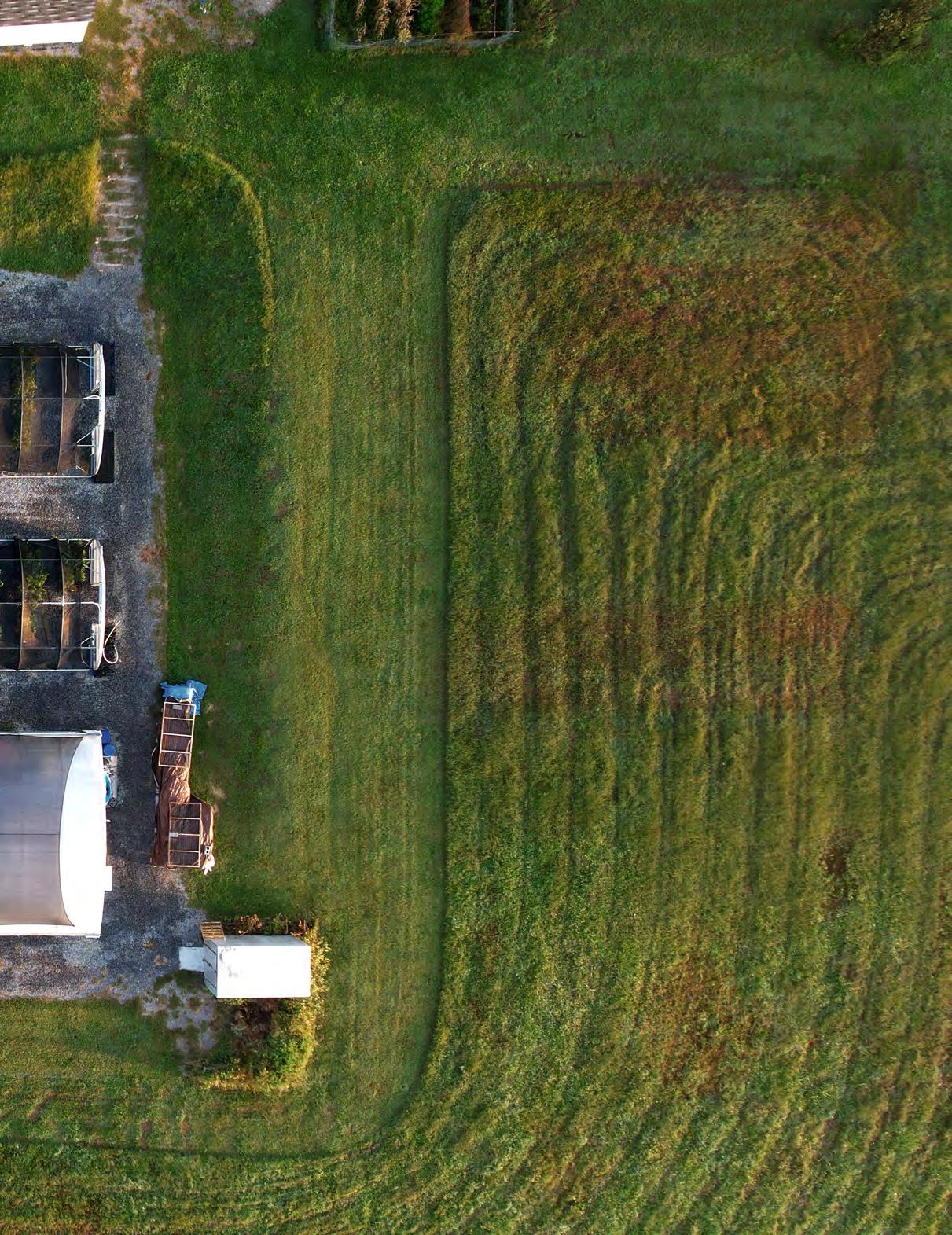
2023 SPRING APPEAL

HELP US BUILD A YEAR-ROUND GREENHOUSE TOWARD EXPONENTIAL PROGRESS.
The chill of winter has finally given way to warmer air and a new level of energy as we enter another growing season. As science continues to advance, staff at Meadowview Research Farms are committed to utilizing the latest technologies. We are building greater efficiencies now for successful restoration tomorrow. Your support of TACF’s 2023 Spring Appeal will allow us to purchase a year-round greenhouse.
Presently, Meadowview has a greenhouse running at capacity January through April, and two shade houses that assist from May through November to grow 5,000+ containerized seedlings. The new greenhouse will multiply capacity because of its ability to control the environment year-round.
With your help, this much needed addition toward leading edge research will:
• increase high-quality seedling production,
• provide a climate-controlled, year-round space for greenhouse trials that propel our science, and
• accelerate pollen production for breeding of transgenic and grafted wild-type American chestnuts.
This new greenhouse is imperative for the exponential progress TACF is experiencing. By supporting our acquisition of a modern, research-grade greenhouse, you power the entire chestnut restoration movement toward bolder research and greater impact, moving us closer to mission success.

MEADOWVIEW 20 ~ A Benefit to Members
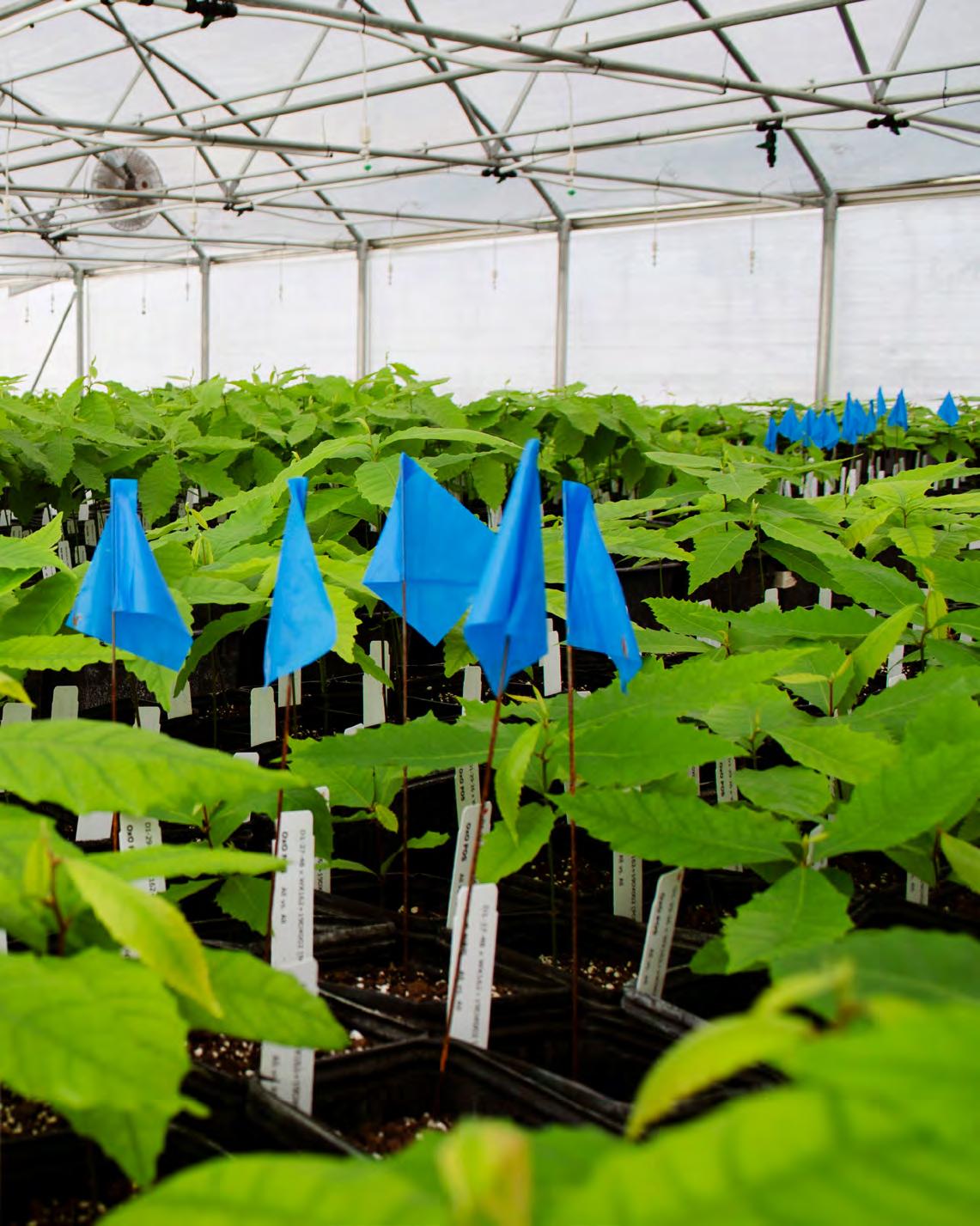
A View FROM
MEADOWVIEW
TACF continues to test a variety of avenues toward chestnut restoration including breeding, biotechnology, and biological control. At this pivotal moment for the entire chestnut restoration community, we are embarking on long-term side-by-side evaluation of our most promising efforts to produce disease-resistant trees that will be suitable for reintroduction into forests where they will have to compete for canopy dominance. Ciera Wilbur, Nursery Manager at TACF’s Meadowview Research Farms, is seen here applying a neem oil root drench as part of integrated pest management across thousands of month-old seedlings in the greenhouse. The seedlings surrounding Ciera are part of Meadowview’s ambitious ‘All versus All’ trial, comparing the best-of-the-best backcross trees, diversified Darling 58 trees based on the work at SUNY-ESF, ‘Stacked Resistance’ trees combining Chinese and transgenic sources of resistance, as well as American, Chinese, and hybrid controls. Following small stem blight assays in 2023, these seedlings will be bound for long term evaluation in orchard and forested settings in 2024.
The Journal of The American Chestnut Foundation ~ 21 MEADOWVIEW The Journal of The American Chestnut Foundation ~
Hindsight is 2008:
REVISITING TACF’S OLDEST PROGENY TESTS
By Sara Fitzsimmons, TACF Chief Conservation Officer
Growing trees requires patience, and it can be difficult to see progress on an annual basis. While big changes can occur in just a few years, conceptualizing and internalizing long-term change can be improved by comparing before and after pictures, as well as taking measurements and quantifying those changes.
As we eagerly await deregulation of Darling 58 and a new era of American chestnut reintroduction, our staff and volunteers have been revisiting early progeny testing sites of B3F3s. Those plantings were first established in 2008, and new plantings have been established annually since then.
While we now know that blight resistance is much more complicated than originally presumed, those early sites have given us great resources for compiling and updating best management practices for American chestnut reintroduction and restoration.
The pictures here showcase two progeny tests sites. Figure 1 shows the progression of a progeny test established in southwestern VA, in the Jefferson National Forest. In picture 1A, the site is shown just prior to planting. Preparation for planting follows the “Testing Task Force Protocol” established by TACF, removing a majority of the overstory

RSC COLUMN 22 ~ acf.org
to a residual basal area of 30 ft2/acre. 1,080 bareroot seedlings were planted on this site in the fall of 2011 and 2012. In picture 1B, Carl Absher is showcasing growth of both planted American chestnuts and natural regeneration in the fall of 2021. Carl is a long-time chestnut grower and volunteer for TACF. A professional arborist in east Tennessee, he returned to his childhood home near Blacksburg, VA. Shortly following retirement, he helped site and install one of the earliest B3F3 progeny testing sites.
Figure 2 shows another progeny test established in northeastern PA, on part of the Blooming Grove Hunt Club (BGHC) in Pike County. Robin Wildermuth, pictured in Figure 2A, is a consulting forester in Pike County, who spent a large portion of his career with BGHC. Through his efforts, the Club has planted over 3,000 chestnuts of various pedigree and generation. In the 2017 progeny test showcased in Figure 2, Robin and the BGHC followed the Testing Task Force Protocols mentioned above, establishing 824 seedlings in the
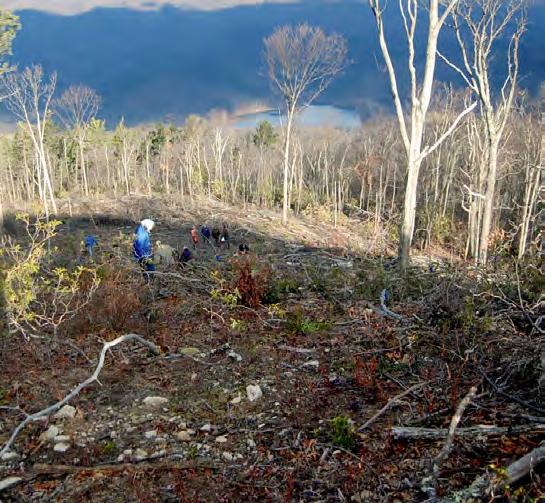
 1A. Planting of B3F3 progeny test at John’s Creek in the Jefferson National Forest in 2011.
1B. Carl Absher observes the John’s Creek progeny test planting in fall of 2021.
1A. Planting of B3F3 progeny test at John’s Creek in the Jefferson National Forest in 2011.
1B. Carl Absher observes the John’s Creek progeny test planting in fall of 2021.
The Journal of The American Chestnut Foundation ~ 23 RSC COLUMN
Figure 1. Progression of Jefferson National Forest Progeny Test
spring of 2017. Following Robin’s retirement as forester at BGHC, Devin Schappert assumed that role and is shown next to a 4-year old B3F3 American chestnut in Figure 2B. These trees are rivaling growth of the dense yellow birch and, in many cases, outgrowing that competition.
On the quantification side, Research Forester Stacy Clark, with the U.S. Forest Service, recently published an 8-year retrospective on some of the first B3F3 progeny tests established with TACF (Clark et al 2023). Her conclusions echo that of many others observing these long-term American chestnut installations:
Site selection is the most vital ingredient to assuring success in American chestnut establishment;
resistance to Phytophthora root rot will be essential to American chestnut reintroduction, especially in the South; and
the more vigorous a seedling at outplanting, the better the tree will do long-term.
From many years of planting and growing, staff, volunteers, and partners of TACF have learned much about the silvicultural requirements for the species, and have published them as best management practices (TACF, 2023). With funding help from the Sustainable Forestry Initiative (SFI), we published our first version of the document in 2010, and recently incorporated updates. This document outlines the best management practices currently know regarding reintroduction of American chestnut. These recommendations are not optimized for specific locations but, instead, offer the most suitable methods for most locations and situations. Optimized methodologies for a specific location and reintroduction scenario require more in-depth analysis of soil characteristics, land-use history, surrounding invasive species pressure, local herbivore pressure, and site manager resources available for project installation and long-term maintenance.
There are many other resources available outlining methods for planting and growing chestnuts. The best resources come from those most experienced in local methods. For those interested in growing American chestnut trees, we recommend getting involved with a state chapter of TACF to learn from volunteer leaders who have the most experience at the local level.
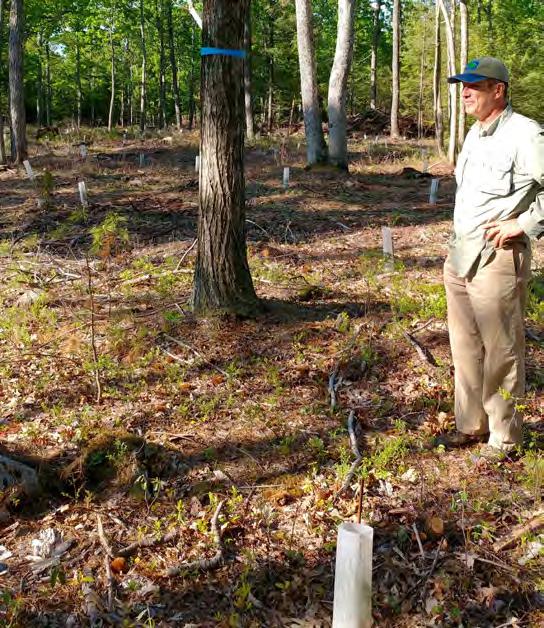
2A. Robin Wildermuth stands next to a recently planted B3F3 American chestnut (in an 18" plastic tree tube), near the base of a mature wild-type American chestnut (with blue flagging in the middle). The planting occurred in spring 2017.

2B. Devin Schappert stands beside a B3F3 American chestnut among the Blooming Grove progeny test in spring of 2021. The competing yellow birch are already leafed out while the B3F3 American chestnuts are just starting bud swell.
CITED AND OTHER RESOURCES
Clark SL, Schlarbaum SE, Saxton AM, Jeffers SN, and RE Baird. 2023. Eight-year field performance of backcross American chestnut (Castanea dentata) seedlings planted in the southern Appalachians, USA. Forest Ecology and Management. 532 (2023). https://doi.org/10.1016/j.foreco.2023.120820. The American Chestnut Foundation. 2023. Best Management Practices for American Chestnut Reintroduction. https://ecosystems.psu.edu/research/chestnut/ breeding/planting/tacf_sfi_bmps_2023.pdf. Last accessed March 22, 2023. Chestnut Chat archives, in particular the sessions on Site Selection (#24 by Sara Fitzsimmons) and Restoration (#11 by Dr. Stacy Clark): https://acf.org/chestnutchat-archives/ Penn State Growers website: https://ecosystems.psu.edu/research/chestnut/breeding/planting
24 ~ A Benefit to Members RSC COLUMN
Figure 2. Blooming Grove Hunt Club (BGHC) Progeny Test

NATIONAL VOLUNTEER WEEK

During the week of April 16 to April 22, our country observed National Volunteer Week. This special period of recognition honors the millions of stewards who work together, inspired by an end goal they may never see realized. They are an invaluable gift to organizations like The American Chestnut Foundation (TACF).
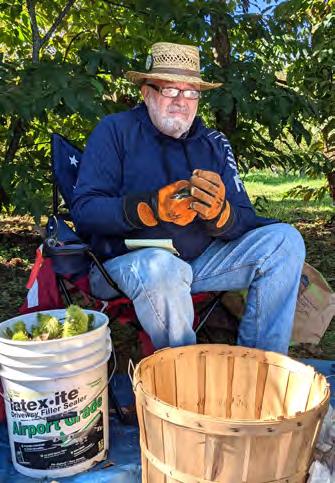
TACF has several thousand resolute, boots-on-the-ground volunteers, from Maine to Alabama, without whom our vision of a robust eastern forest restored to its splendor would be possible.
We sincerely thank all who volunteer in varying roles to make the restoration of the American chestnut what it is today –a steadfast mission progressing closer to reality. We are truly grateful for the skills, passion, and labor contributed by each individual, which together ensures success.
WANT TO GET INVOLVED?
Visit acf.org/contact-tacf/ and join us in this bold restoration journey!
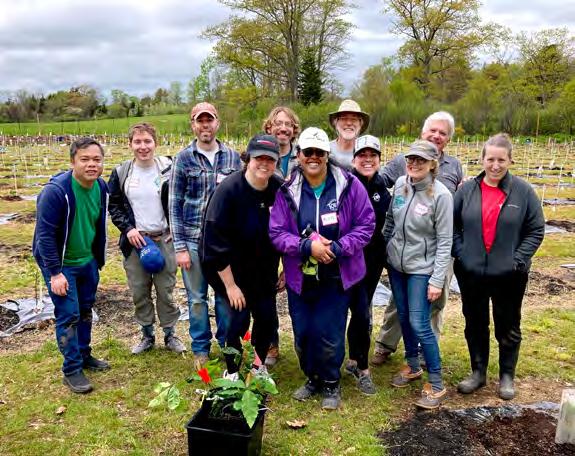


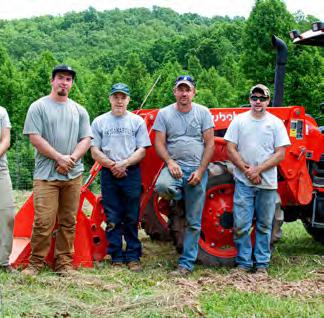


Feeding Insects:
HOW WILL REINTRODUCED CHESTNUTS FULFILL THIS ECOLOGICAL FUNCTION?
By Mike Aucott, PA/NJ Chapter
 White-blotched Heterocampa (Heterocampa umbrata) caterpillar.
White-blotched Heterocampa (Heterocampa umbrata) caterpillar.
THE SCIENCE 26 ~ acf.org
Photo by Doug Tallamy.
The reintroduced American chestnut must be blight-tolerant and capable of reaching the canopy in the North American forest. It should also fill the ecological niche of the pre-blight chestnut in key ways.
One important trait is an ability to feed caterpillars. Invertebrates such as caterpillars are more important in the maintenance of ecosystems than vertebrates (Wilson, 1987). In most forests of the world, caterpillars consume more living leaves than all other animals combined (Janzen, 1988). Insect herbivores are near the hub of most terrestrial food webs, comprising essential food for insect predators and parasitoids, spiders, amphibians, lizards, rodents, bats, birds, and even higher predators such as foxes and bears (Burghardt, et al., 2010).
At least 310 North American bird species are known to feed extensively on caterpillars, and the majority of terrestrial birds rely on insects during reproduction and other nutrientlimited periods in the annual cycle (Narango, Tallamy & Marra, 2018). Caterpillars and moths are the largest
component of nestling diets in hundreds of species of migrant bird species (Tallamy & Shriver, 2021).
Plants produce a variety of phytochemicals to defend against insect predation. Most species of plant-eating insects are specialists; they have evolved mechanisms to

subvert or override the chemical defenses of native plants with which they have co-evolved (Forister, et al., 2014). Because many members of a single plant lineage typically share chemical defenses based on a common compound (Berenbaum 1990), a non-native plant is most
 C. dentata leaves
Hybrid chestnut leaves
Figure 1
C. dentata leaves
Hybrid chestnut leaves
Figure 1
THE SCIENCE The Journal of The American Chestnut Foundation ~ 27
Figure 2
likely to share the chemical defense of a native species if it is closely related to that species. If non-native plants use chemical defenses similar to those of a native plant, they may be acceptable food plants for adapted local specialists (Tallamy 2004).
Indeed, caterpillars and moths have been found to oviposit and feed on geographically novel plant species that were congeners of native host species more often than novel species that were unrelated to native hosts (Burghardt, et al., 2010). Generally, C. dentata, C. mollissima, and
C. crenata are related closely enough to interbreed successfully. It thus seems likely that hybrid chestnut trees, especially if they have a relatively high percentage of C. dentata genes, would be similar to wild chestnuts in their ability to feed caterpillars.
Nevertheless, the possibility exists that hybrid chestnuts might not have the ability to serve as host plants for as large a number of individuals and species of caterpillars as pure C. dentata. To examine this question, an orchard in northern Pennsylvania was chosen. This orchard contains
DISTRIBUTION; % OF LEAF EATEN: AMERICAN
[>40] [35, 40] [30, 35] [25, 30] Number of Leaves
[0, 5][5, 10]
[10, 15][15, 20][20, 25]
Percent Eaten
DISTRIBUTION; % OF LEAF EATEN: ASIAN / AMERICAN HYBRID TREES
[10, 15][15, 20][20, 25] [>40] [35, 40] [30, 35] [25, 30] Number of Leaves
[0, 5][5, 10]
Percent Eaten
Both groups of trees showed the same highly skewed pattern of leaf predation. Nearly 300 of the 350 leaves examined for each group had between 0 and 5% of their estimated total area eaten. A few leaves in each group were heavily eaten.
a mix of 10-year-old hybrid trees and essentially pure American trees growing in close proximity. The hybrids are F2 intercrosses of 50/50 Asian/American trees and have Asian ancestry that varies from approximately 20% to 80%. The orchard thus provides an opportunity to compare insect predation of hybrids vs. Americans. These hybrids’ average Asian parentage is likely as high as any chestnut trees to be considered for restoration.
Competence at estimating the percent of a leaf that had been eaten was developed using ImageJ software (ImageJ, 2022). ImageJ allows a user to trace the outline of the shape of an image in a digital picture file, such as a JPG file. Once a shape is outlined, ImageJ can calculate its area. The areas of 168 leaves were measured, and then the areas of the missing and presumed eaten areas of each leaf were measured and the total percent eaten was calculated. Visual estimates were compared with ImageJ’s calculated estimates in an iterative manner until the researcher’s estimation ability improved to where it was close to the ImageJ calculations. Relying on visual estimates is much faster than using imaging software exclusively and, once competence in estimation is developed, nearly as accurate (Tallamy, 2022).
Fifty sequentially located leaves on randomly selected breast-high branches on the southern sides of each of seven F2 hybrid trees and seven American trees, totaling 350 leaves in each group, were examined on September 4, 2022. By this time, eaten areas were present on many leaves (Figures 1 and 2). The percent of each leaf area that was missing was estimated. It was assumed that missing areas of leaves had been eaten by chewing insects, primarily caterpillars. Any leaves that showed the characteristic skeletonizing of leaf tissue caused by Japanese beetles were not included.
The distribution pattern of the hybrid and American trees was similar, with
TREES
350 300 250 200 150 100 50 0
350 300 250 200 150 100 50 0
A B THE SCIENCE 28 ~ A Benefit to Members
Figure 3
PERCENTAGE OF LEAVES WITH INDICATED DEGREE OF PREDATION, AMERICAN AND HYBRID TREES
American chestnut Asian/American chestnut hybrid
Approximately two thirds of the leaves from the American trees showed some eaten areas, whereas less than 60% of the leaves from the hybrid trees had eaten areas. About 50% of the American leaves with some eaten areas had between 0 and 5% eaten, whereas only about 40% of the leaves from the hybrid trees had this degree of predation. These differences were statistically significant. Smaller percentages of leaves showed greater predation; differences between the Americans and hybrids with these more heavily eaten leaves were not significant.
most leaves showing little or no damage but some leaves showing heavy predation (Figure 3A and B). The mean percentage of leaf eaten of each of the two groups of trees was determined. The seven hybrid trees were found to have eaten areas representing an average of 4.1% of each leaf, and the seven American trees had eaten areas averaging 3.9% of each leaf. Based on a MannWhitney non-parametric statistical test (InStat, 2022), these percentages
REFERENCES
were not significantly different, with a two-tailed P value of 0.0835. This result suggests that leaf-eating insects register no difference between approximately 50% Asian hybrids and American chestnuts.
However, a closer look at the portion of leaves with little or no damage showed a difference. Two-thirds of the American trees’ leaves showed some predation, compared to less than 60% of the hybrids. Most of this difference
Berenbaum, M. R. 1990, Coevolution between herbivorous insects and plants: tempo and orchestration. Pages 87–89 in F. Gilbert, editor. Insect life cycles, Springer Press, London.
Burghardt, Karin T., D. W. Tallamy, C. Philips, and K. Shropshire, 2010, Non-native plants reduce abundance, richness, and host specialization in lepidopteran communities, Ecosphere 1: 1-22.
Forister, M. L., et al., 2014, The global distribution of diet breadth in insect herbivores, PNAS 112: 442-447. ImageJ, 2022, https://imagej.nih.gov/ij/index.html accessed August, 2022. InStat, 2022, https://www.graphpad.com/scientific-software/instat/, accessed November, 2022.
was due to a greater percentage of American leaves showing damage in the 0 to 5% category. These differences were significant, with estimated two-tailed P values of 0.019 and 0.015, respectively. Differences in the percentages of leaves eaten in the higher predation ranges were not significant (Figure 4).
These results should be considered preliminary. One reason is that the site is in the northwest plateau region of Pennsylvania at 2,200 feet elevation, on former agricultural land. This location is not typical of much of the chestnut’s former range; other areas may have different rates of insect predation and different insects involved. Another reason for caution in interpreting these results is that the American chestnut trees in the study are not pure American; they are Kelley x Amherst trees, which recent genetic analysis indicates are approximately 94% C. dentata and 6% C. sativa. A third reason is that the sample size was relatively small and represents only a single year of data collection.
Nevertheless, these results show it is possible to investigate the ability of chestnuts to fill an important aspect of the tree’s ecological niche; its ability to feed caterpillars. More research is needed to explore whether the pattern of 1) overall similarity in percentage of leaf areas eaten and 2) a greater level of relatively minor predation on American trees will hold with trees including B3F3 chestnuts and chestnuts growing in other locales.
Janzen, Daniel H., 1988, Ecological Characterization of a Costa Rican Dry Forest Caterpillar Fauna, Biotropica, 20, 120-135.
Narango, D., D. Tallamy, and P. Marra, 2018, Nonnative plants reduce population growth of an insectivorous bird, PNAS 115: 11549–11554.
Tallamy, D. and W.G. Shriver, 2021, Are declines in insects and insectivorous birds related?, Ornithological Applications 123: 1–8, DOI: 10.1093/ornithapp/duaa059
Tallamy, D. W. 2004, Do alien plants reduce insect biomass? Conservation Biology 18:1689–1692.
Tallamy, D., 2022, personal communication, email of 8/23/22.
Wilson, Edward O., 1987, The Little Things That Run the World (The Importance and Conservation of Invertebrates), Conservation Biology, 1, 344-346
Eaten Areas>0%, <5% Eaten >5%, <20% Eaten >20% Eaten 70% 60% 50% 40% 30% 20% 10% 0% Percent of Leaves
Some
THE SCIENCE The Journal of The American Chestnut Foundation ~ 29
Figure 4
Forest Management Strategies
THAT ALLEVIATED COMPETITION AND INCREASED SURVIVAL OF CHESTNUT HYBRIDS AFTER FIVE YEARS
By Heather Griscom1, Zoe Bergman1, Cassie Stark1,2, and Cindy Ingram1
 1James Madison University, Harrisonburg, VA
2The American Chestnut Foundation, Meadowview, VA
1James Madison University, Harrisonburg, VA
2The American Chestnut Foundation, Meadowview, VA
30 ~ acf.org THE SCIENCE
View from top of ridge where chestnut research sites were established in Appalachian Cove in West Virginia.
INTRODUCTION
American chestnut (Castanea dentata (Marsh) Borkh.), once a co-dominant canopy species in eastern U.S. forests, has been functionally extinct for almost a century. Hybrid American-Chinese chestnuts of intermediate blight resistance present an opportunity to study its functional niche. Few studies have quantified growth performance of hybrid chestnuts in forest ecosystems as most have occurred in orchards. The objective of this research was to identify silvicultural strategies related to light, herbivory, and competition for increasing the success of hybrid chestnut (BC3F3 generation) plantings in an Appalachian cove forest ecosystem in West Virginia. We hypothesized that manipulating light through gap creation, controlling for competition with landscape fabric, and inhibiting rodent predation through the use of tree shelters would affect the growth and survival of chestnut hybrids after five years in an Appalachian cove forest.
METHODS
In 2015, the research team acquired 400 1-year-old hybrid chestnuts (BC3F3) in 1-quart containers from The American Chestnut Foundation’s breeding orchard in Meadowview, Virginia. At each of eight sites, fifty seedlings were planted with a deer fence erected around the perimeter (Figure 1). For the purpose of this experiment, trees and vegetation were removed to create “large” or “small” gaps at each site. Large gap sites were 32m in diameter, to produce a canopy openness of 60% and small gap sites were 12m in diameter, to produce a canopy openness of 40%. Black woven polypropylene landscape fabric, was randomly placed on every other row of seedlings, which were planted in the center of these strips. In each plot, half of the seedlings were randomly selected to be protected with a short tree shelter (Figure 1, Figure 2). Height, basal diameter, and survival were recorded every year for five growing seasons (2015–2019).
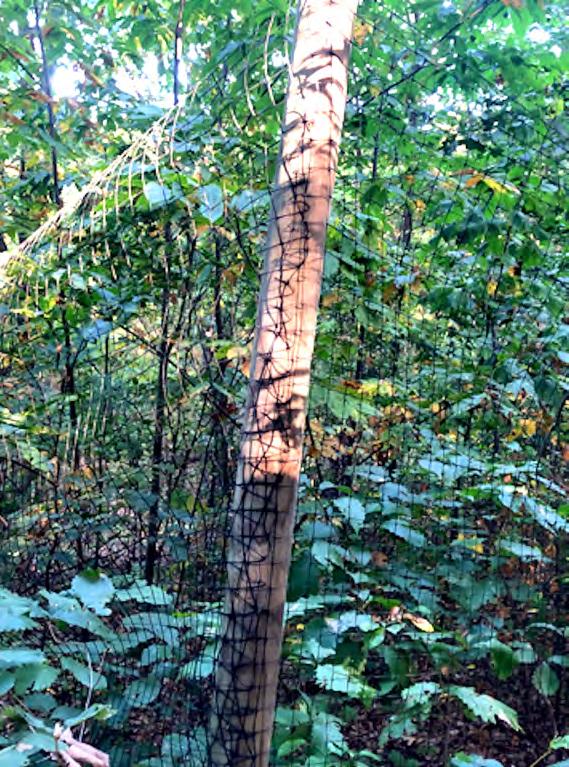
 Figure 1
Figure 1
The Journal of The American Chestnut Foundation ~ 31 THE SCIENCE
Hybrid chestnut study site in Appalachian Cove in West Virginia with deer fence around the perimeter (left). Hybrid chestnut seedling with short tree shelter in study site (right).
RESULTS AND DISCUSSION
Growth results
After five years, landscape fabric had a positive effect on diameter growth whereas tree shelters and gap size had no effect on diameter. Furthermore, landscape fabric application interacted with gap size to affect tree height. Chestnuts in large gaps with landscape fabric were taller than chestnuts in large gaps without landscape fabric (Figure 3). In small gaps, landscape fabric did not have an effect on height (Figure 3). This difference is likely due to vegetative competition. In large gaps, higher light levels led to increased competition with light-demanding, early successional species, which are less abundant in smaller gaps or on the shaded forest floor. The addition of landscape fabric likely mitigated competition in large gaps whereas landscape fabric was not needed in small gaps due to decreased competition associated with less light.
Survival results
Chestnut seedling survival was greater in small gaps than in large gaps regardless of landscape fabric or tree shelter presence. By fall of 2019, 69% of seedlings were alive in small gaps compared to 42% of chestnuts in large gaps. The greatest survival was in small gaps with landscape fabric and tree shelters present (Figure 4). Poor survival in large gaps may have been due to increased vegetative
competition and potentially heavier rodent predation due to increased ground cover (Griscom and Griscom 2012). The initial lower light conditions in experimental small gaps may have enabled chestnut seedlings to survive and establish themselves without being outcompeted by light-demanding, fast-growing species. The American chestnut is a species with intermediate shade tolerance and
A representation of the experimental design. A deer exclusion fence was constructed around each planting site. The beige stripes represent landscape fabric, and the gray cylinders represent randomly placed tree shelters.
Average height (cm) growth of chestnut seedlings after five years in an Appalachian Cove Forest in West Virginia. The uppercase letters represent significant differences from a three-way ANOVA, error bars are plus or minus one standard deviation. Groups that do not share any letters are significantly different from one another.
The sum of chestnuts alive represented as a percentage from 2015 to 2019 within different treatments.
10m 10m 1m
2015 YEAR % OF CHESTNUTS ALIVE 100 80 60 40 2016 2017 2018 2019 GAP SIZE Large Small LANDSCAPE FABRIC Absent Present TREE SHELTER Absent Present
Figure 2
B Large A AB Small GAP SIZE MEAN HEIGHT GROWTH CHANGE (cm) AB LANDSCAPE FABRIC Absent Present 40 30 20 10 0
Figure 4
THE SCIENCE 32 ~ A Benefit to Members
Figure 3
is physiologically equipped to compete in the understory until more light becomes available (Joesting et al. 2009). Other studies have found that, while chestnuts’ growth is greatest in areas with high light levels, their ability to compete with other shrub and vine species (such as Rubus spp. and Smilax spp.) is maximized in areas with intermediate light levels (Pinchot et al. 2017).
SUMMARY
Chestnut plantings in small gaps offer a low-cost management approach that yields higher survival rates (Figure 4). If chestnut seedlings are planted in large gaps with high-light conditions, managing for competing vegetation is recommended, although this comes at an additional cost. Silvicultural practices such as underplanting and release or gap phase regeneration
would likely provide a less intensive introduction of hybrid chestnuts (Wang et al. 2006). This research contributes to best practices for introducing chestnut hybrids in productive, forested ecosystems.
REFERENCES
Griscom HP, Griscom BW (2012) Evaluating the ecological niche of American chestnut for optimal hybrid seedling reintroduction sites in the Appalachian ridge and valley province. New Forests 43(4) 441–455
Joesting HM, McCarthy BC, Brown KJ (2009) Determining the shade tolerance of American chestnut using morphological and physiological leaf parameters. Forest Ecology and Management 257(1) 280–286
Pinchot CC, Schlarbaum SE, Clark SL, Saxton AM, Sharp AM, Schweitzer CJ, Hebard FV (2017) Growth, survival, and competitive ability of chestnut (Castanea Mill.) seedlings planted across a gradient of light levels. New Forests 48(4) 491–512
Wang, GG, Bauerle, WL, Mudder, BT (2006) Effects of light acclimation on the photosynthesis, growth, and biomass allocation in American chestnut (Castanea dentata) seedlings. Forest Ecology and Management 226(1–3) 173–180
2023 American Chestnut Photo Contest
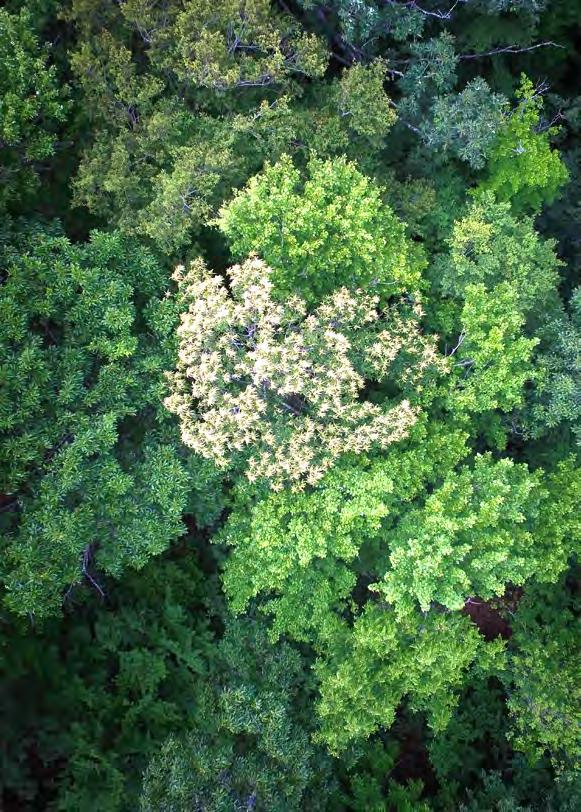
LET YOUR CREATIVITY SHINE IN THIS YEAR’S PHOTO CONTEST
Capture the best features of American chestnuts or American chestnut hybrids by experimenting with various angles, focal points, and distances. Submissions that collectively represent every season give us the opportunity to highlight the tree’s best features. The winner will receive a one-year membership to TACF and the winning photo will be published on the cover of Chestnut. Second- and third-place winners are also recognized along with an occasional runner-up. So, get out there and give it your best shot!
ALL ENTIRES MUST:
• be submitted digitally via email to jules.smith@acf.org or a link to a cloud drive by September 1, 2023;
• relate to the American chestnut;
• be at least 2400 x 3000 pixels (7.6 MBs) and submitted in a jpeg or tiff file format;
• include name of photographer and contact information;
• include a full caption containing names of subject(s), location, and title;
• be limited to a total of five photos;
• be previously unpublished and cannot be entered into another contest.
MORE INFORMATION AT: acf.org/2023-american-chestnut-photo-contest/
Full text available at Trees, Forests and People: doi.org/10.1016/j.tfp.2022.100344
THE SCIENCE
PHOTO CREDIT: “Standing Out in a Crowd” by Matt Nichols, winner of the 2019 American Chestnut Photo Contest.


114-Foot-Tall Tree
By Logan Bradd, Poetry Winner Alexander High School, Douglasville, GA
A symbol of America, the 114-foot-tall tree
The tallest American chestnut, it is believed to be
It stands alone, in the middle of an empty forest
It grows quick, faster than a river’s torrent
Its thick branches, thicker than a football lineman
Its white flowers, more majestic than a sunsets’ horizon
Its green leaf, to put it simple is thin and long
But each vein, resembling a snakes’ scales, sings a song
But alas, from the hills, the Asian chestnut came
The American chestnut tried to fight the blight, in vain
It disappeared from the slopes, from the mountain top
It disappeared from the plains, from the piedmont
But not too long ago, we found the tree in Maine
Standing alone, 114 feet tall, in the rain
The lonesome tree, a testament to its resilience
Gives us hope for numbers back in the billions
So as present becomes past and as future becomes present
And as the frame of time approaches and as the frame of time passes
And if we are persistent to finish the job and persistent to finish the plan
We can sleep rest assured that the American chestnut will return to its homeland
REFLECTIONS 34 ~ acf.org
Dairy-Free Chestnut Parfait
Recipe shared by Cherin Marmon-Saxe, TACF Director of Operations
This chestnut parfait is based on a chestnut trifle recipe from Del’s Cooking Twist, a plant-based recipes website. Our version is dairy-free (DF). It can easily be adapted to meet gluten-free dietary requirements as well.

INSTRUCTIONS
INGREDIENTS
For the biscuit layer:
5.3 ounces digestive biscuits or graham crackers
¼ cup unsalted DF butter, melted
Handful of praline pecans
For the mascarpone layer:
5.3 ounces DF cream cheese
⅔ cup DF heavy cream, whipped up in Chantilly (whipped cream, usually flavored with vanilla)
Confectioners sugar, to taste
For the chestnut purée:
12-13 ounces boiled chestnuts
2 cups unsweetened almond milk or other DF milk
1-2 tablespoons granulated sugar
½ vanilla bean seeds, scraped
Pinch of salt (optional)
For the chestnut layer:
5.3 ounces whole chestnuts, crumbled
6 teaspoons chestnut purée
For the chestnut mousse:
7 ounces chestnut purée
1/3 cup + 1 Tablespoon DF heavy cream
For decoration:
Soft peaked meringue
Shaved dark chocolate
For the biscuit base: In a food processor, pulse biscuits and praline pecans until entirely crumbled. Add melted butter, stir well, and divide into 6 to 8 jars depending on their size.
For the mascarpone filling: Whip 2/3 cup of DF heavy cream into Chantilly with a hand mixer or a stand mixer. Using a rubber spatula, fold into the DF cream cheese, a few tablespoons at a time to achieve a light, creamy consistency. Add a few shakes (to taste) of confectioner’s sugar for a bit of sweetness. Divide into the jars, using a piping bag for best results.
For the chestnut purée: In a medium saucepan, whisk together the DF milk with the sugar over medium heat. Dissolve the sugar, then add the cooked chestnuts and vanilla bean (scraped seeds and pod) and bring to a low simmer for about 20 minutes or until there are ½-⅔ cups of liquid left. Stir occasionally, especially towards the end of the cooking time to prevent scorching. Discard the vanilla pod. Transfer the chestnuts, without the liquid, to a food processor and purée until smooth. Add some of the liquid until the desired consistency is achieved.
For the chestnut layer: Add a few spoonful’s of chestnut purée to each jar, then crumbled whole chestnuts in a thin layer.
For the chestnut mousse: Whip the DF heavy cream in a Chantilly, then gently fold in the chestnut purée in two or three additions. Do not overmix. Transfer into a piping bag, then pipe over each jar, finishing up with a soft peaked meringue and shaved dark chocolate.
Keep refrigerated until serving.
*Find the original recipes at delscookingtwist.com/easy-no-bake-chestnut-trifles and shelovesbiscotti.com/chestnut-puree-recipe
The Journal of The American Chestnut Foundation ~ 35 RECIPE
Lessons Learned from Blair Carbaugh
By Dave Crowl, Close Friend of Blair
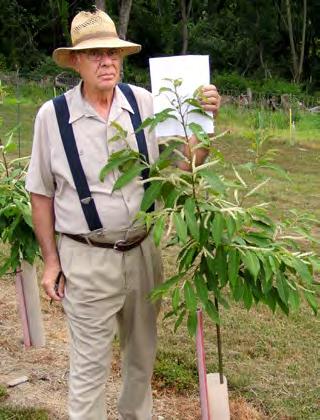
Blair Carbaugh, PA/NJ Chapter, was a force in the restoration efforts of the American chestnut for decades. He was my conservation mentor for more than 15 years. We first met when I took his place as public director at the Northumberland County Conservation District. Blair thought it would be a good idea for young folks to learn the ropes. He always kept an eye on the future. That is the first lesson I learned from Blair.
He was poised to teach me a lot more. Our county has 6,500 acres of abandoned mine lands in the Anthracite Outdoor Adventure Area. Working tirelessly, Blair convinced the Bureau of Abandoned Mine Reclamation, the Appalachian Regional Reforestation Initiative, and The American Chestnut Foundation (TACF) to plant experimental American chestnut trees on the abandoned mine lands. We recruited volunteers in a broad search –from conservation professionals to inmates at the county prison. Blair never missed an opportunity to educate. He treated everyone equally, from the expert to the beginner. That is the second lesson I learned from Blair.
Though Blair’s last few years were challenging, there was never a complaint. Upon my visits with guests to his farm, he was always hospitable with a friendly “Hi, glad to see you!” He made everyone feel welcome. That is the third lesson I learned from Blair.
We must also credit Blair’s partner in all good works; his wife Mary. We send our condolences to Mary and their family. Many thanks to those who have donated to TACF in Blair's memory. That list of names can be found on the next page (In Honor and In Memory).

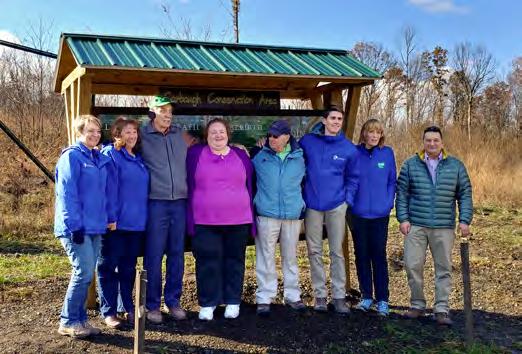 Blair highlights the growth of this 3-year-old chestnut sapling.
DAVE CROWL is an Associate at the Northumberland County Conservation District and a member of the Anthracite Outdoor Adventure Area.
Blair and Mary Carbaugh.
Blair highlights the growth of this 3-year-old chestnut sapling.
DAVE CROWL is an Associate at the Northumberland County Conservation District and a member of the Anthracite Outdoor Adventure Area.
Blair and Mary Carbaugh.
TRIBUTE 36 ~ A Benefit to Members
Blair (third from left) poses with others for a group photo at the Carbaugh Conservation Area.
IN MEMORY AND IN HONOR OF OUR TACF MEMBERS
JANUARY
6, 2023 – APRIL 6, 2023
IN MEMORY IN HONOR

Tom Boggs From: Beni Head
James Ely Bradfield
From:
John G. and Amy Bradfield
Kadir Cannon From: Margaret Vaughn
Blair Carbaugh
From:
Paula and Gregory Benkovic
Mark and Joanne Deibler
Scott and Joyce Ladner
Duane and Maria Moberg
Northumberland County Anthracite
Outdoor Adventure Area Authority
William J. Chestnut
From: Linda Chestnut
Fredric L. Cheyette From:
Catherine and Oren Cheyette
Judy Coker From:
Sima R. Cooperman
George Dumaine From:
Alexander Dumaine
Steve Hanson From:
Bruce Anderson
Vincent Hatton
From: Anne L. Hatton
Kenneth S. Lay
From:
Kenneth G. Lay
Carlton Moseley
From: Margaret Vaughn
Bill and Mary Myser
From: Benjamin Myser
Cartter Patten
From:
David W. Morris
Suzanne Gwynn
Thomas Franklin Pitzer From:
Denise and Jim Blakeney
Michael P. Pollack From:
Mark A. Pollack
John C. “Jack” Rist From:
David W. Morris
Geneva Tyler Schroth From:
Nyla Gaylord
Lee Bascombe Styles From: Marshall Styles
Scott Tepke From:
John & Brenda Weyant
Robert Fish
Will Keesler
Glen Tepke
Jeanne Hickey
Jeffrey Mack
John K Lee
Mary Ellen and Larry Heasley
Ryan Dearing
We regret any errors or omissions and hope you will bring them to our attention.
Steven Barilovits III From: Dr. Paul H. Sisco Jr.
Terrence Bevins From: Shawn Bevins
Cy Brame From:
Karen B. Glover
Rodney Byam From:
Jennifer Byam
Holy Earth Mother From:
CedarLight Grove, ADF
Austin M. Jones
From: Janet and Victor Bernhards
Ann Massie
From:
Carolyn Yost
Alan Milliner, MD From: Patricia Bowyer
Moishe from DfD From: Justin Zymbaluk
Kenneth (KO) Summerville From: Bliss Hemric
Lisa Thomson From: Anonymous
Maxwell Turpin From: Devanney Haruta
Darcie Hudson
Mark Wallet From:
Danielle Brenda Salantes
IN HONOR AND IN MEMORY The Journal of The American Chestnut Foundation ~ 37
50

Bolder Research, Greater Impact
Your support of this year’s Spring Appeal will allow TACF’s Meadowview Research Farms to build a year-round greenhouse. The addition of this new facility will provide a climate-controlled space for trials that propel our science and significantly increase seedling and pollen production.
Meadowview’s current greenhouse and two shade houses are an essential part of everyday operations at its Glenn C. Price Farm, but they are running at capacity. Acquiring a modern, research-grade greenhouse is imperative for the exponential progress TACF is experiencing. By supporting this acquisition, you are part of the bold and collective movement toward the restoration of this foundation tree species.

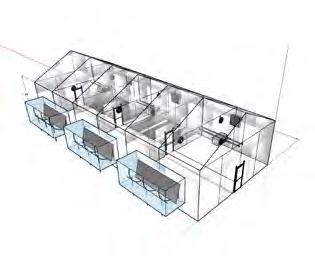
N. Merrimon Avenue Suite 115 Asheville, NC 28804
Help us build greater efficiencies now for successful restoration tomorrow.
2023 SPRING APPEAL





 Lisa Thomson President and CEO
Lisa Thomson President and CEO

 Lisa Thomson, President and CEO The American Chestnut Foundation
Lisa Thomson, President and CEO The American Chestnut Foundation



















 GCO Manager Mark Meehl at Flint Field, Lincoln, MA.
GCO Manager Mark Meehl at Flint Field, Lincoln, MA.















 George Perry’s 100 Birthday celebration. (George is seated fourth from left.)
George Perry’s 100 Birthday celebration. (George is seated fourth from left.)










 1A. Planting of B3F3 progeny test at John’s Creek in the Jefferson National Forest in 2011.
1B. Carl Absher observes the John’s Creek progeny test planting in fall of 2021.
1A. Planting of B3F3 progeny test at John’s Creek in the Jefferson National Forest in 2011.
1B. Carl Absher observes the John’s Creek progeny test planting in fall of 2021.











 White-blotched Heterocampa (Heterocampa umbrata) caterpillar.
White-blotched Heterocampa (Heterocampa umbrata) caterpillar.

 C. dentata leaves
Hybrid chestnut leaves
Figure 1
C. dentata leaves
Hybrid chestnut leaves
Figure 1
 1James Madison University, Harrisonburg, VA
2The American Chestnut Foundation, Meadowview, VA
1James Madison University, Harrisonburg, VA
2The American Chestnut Foundation, Meadowview, VA

 Figure 1
Figure 1






 Blair highlights the growth of this 3-year-old chestnut sapling.
DAVE CROWL is an Associate at the Northumberland County Conservation District and a member of the Anthracite Outdoor Adventure Area.
Blair and Mary Carbaugh.
Blair highlights the growth of this 3-year-old chestnut sapling.
DAVE CROWL is an Associate at the Northumberland County Conservation District and a member of the Anthracite Outdoor Adventure Area.
Blair and Mary Carbaugh.



